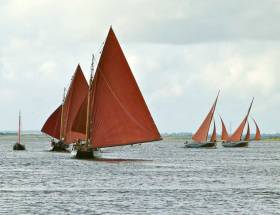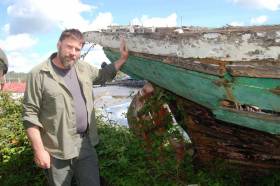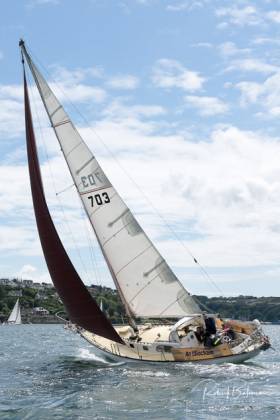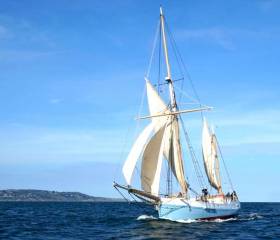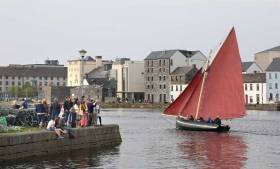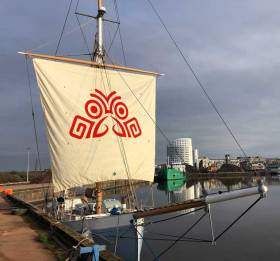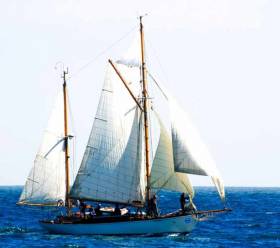Displaying items by tag: Historic Boats
The New Dun Laoghaire? Could Restored Classic Marguerite Point the Way Towards a Reimagined Harbour?
Anyone sailing in Dun Laoghaire on one of those gentler days which have occasionally punctuated this Autumn’s meteorological extremities could have been forgiven if they thought they were seeing a ghost writes W M Nixon. White of hull – very white – and with antique-style hand-made sails of pale cream, her clipper bow and long counter stern place this elegant little vessel in the High Victorian era as she slips effortlessly along, leaving scarcely any trace of wake in the best ghost-like traditions.
But she was real. Real enough to evoke the time when Dublin Bay Sailing Club was still the newly-formed disruptor which had first appeared in 1884. Real enough to recall that the innovating 1870-formed Royal Alfred Yacht Club was continuing to develop fresh ideas in the forefront of the international codification of the yacht racing rules.
For this little wonder is Guy and Jackie Kilroy’s newly-restored 25ft cutter Marguerite, which first sailed in 1896, but was built by a traditionalist who reckoned the classic yachts of the late 1880s and early 1890s were the peak of naval architectural achievement both for beauty of line, and for performance and seaworthiness. In Marguerite, he built his dream.
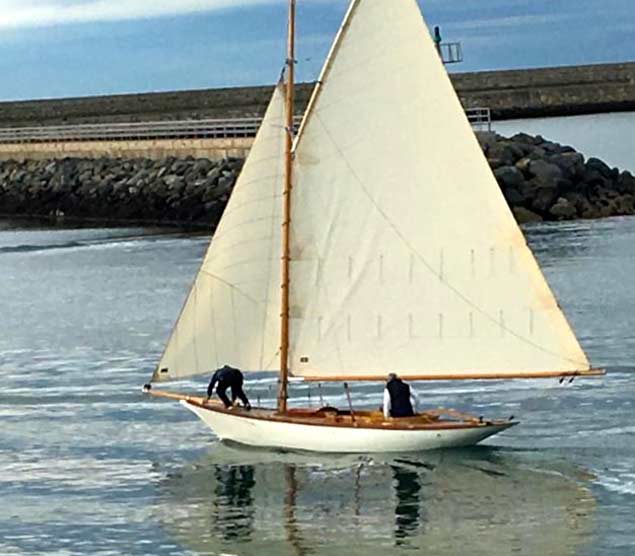 Marguerite has her first sail in restored form, September 2019. Photo: David Williams
Marguerite has her first sail in restored form, September 2019. Photo: David Williams
This boatbuilder was quite something. His busy little yard was in Malahide, but though he was called Jack Wellington, that was an adopted surname, for he was actually Norwegian or Swedish, though nobody quite knew which. It was an easy enough confusion to make, for until 1905 they were a united kingdom with Sweden the dominant partner. But in the small estuary community which was then Malahide, it didn’t much matter either way, as they were accustomed to seafaring men who appeared from God’s knows where, and found a peaceful place to settle in the little village, particularly if they were shipwrights before they were sailors, for the little boatyard was always busy.
Eventually, Jack took it over, and was doing well with fishing boat work such that in 1896 it was decided to build a little yacht. Whether it was for a customer or for Jack himself we don’t know, but we do know that for at least a quarter of a century thereafter, Jack Wellington was the main man on board when Marguerite went sailing and racing.
For her lines, he’d persuaded Herbert Boyd across in Howth – who had designed and built the remarkably accomplished 27ft Eithne in 1893 – to lend him Eithne’s very basic drawings, and he simply scaled them down a bit, and Marguerite was a 25ft version of Eithne.
 Herbert Boyd’s Eithne as she was in 1895, flying the Commodore’s burgee of the newly-established Howth SC
Herbert Boyd’s Eithne as she was in 1895, flying the Commodore’s burgee of the newly-established Howth SC
Herbert Boyd went on to design the Howth 17s in 1897, and they first raced in 1898. But though he would take the helm of one of them from time to time for a race, Eithne remained his first and truest love. She was possibly the smallest-ever yacht listed as owned by the Commodore of the Royal Alfred YC when he was elected to that role for a distinguished period in office, having by now inherited his father Judge Boyd’s baronetcy to become Sir Walter Boyd Bt. In fact, he kept Eithne from when he had built her in the boatshed beside Howth House in 1893 until his death in 1948, and until the late 1920s her closest rival in racing was often her little sister Marguerite from Malahide.
In time, Marguerite passed to members of the Jameson whiskey family, but continued to be based in Malahide, and in the late 1940s she was being sailed by a young Mungo Park - a direct descendant of the legendary explorer, he was Mungo Park VII - but Marguerite came to him through the fact that his mother was a Jameson. He soon moved on to larger boats, becoming one of the keenest owner-skippers in the Dublin Bay 24 Class, and in 1973 his Chance 37 Tam O’Shanter was the top-placed Irish boat in that year’s Fastnet Race, thereby making Mungo Park the first winner of the Gull Salver.
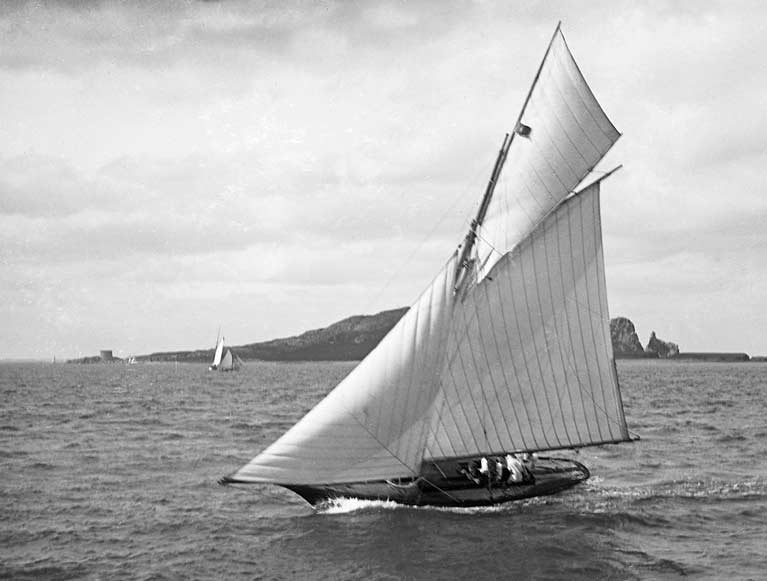 Marguerite in 1896, the only surviving photo of her earliest days.
Marguerite in 1896, the only surviving photo of her earliest days.
As for Marguerite, she was inevitably showing her age and was sold away from Malahide. But somehow she survived, and in the late 1990s, the newly-retired Tim Magennis of Dun Laoghaire – probably the only Irish sailor to have gone round the world under gaff rig, having done it in the 1960s in the Colin Archer ketch Sandefjord – was looking for a retirement project. He was inspired by the fact that Sean Cullen, the son of his skipper on Sandefjord, had restored Eithne in 1984, and when he got to hear that Marguerite was in Arklow in a somewhat sorry state but still eminently restorable, his life path was mapped out for the next twenty years.
He managed to get Marguerite moved to a shed in the old ESB pole-field on Dublin’s East Wall Road, where a select group of Poolbeg Y & BC members winterized their yachts, and there he was able to draw on East Wall’s long-established boat-building skills to bring Marguerite back to life. Her original elegant counter had long since been shortened, but Tim wanted it restored. So I was delegated to bring Mungo Park in from Howth for a conference on how that stern had originally looked, which resulted in what must have been the one and only yacht design consultation which had ever taken place in the Wharf Tavern with a member of the Royal Yacht Squadron leading the discussion.
Despite such high-flying advisers, as he lived on his retirement pension Tim was determined to keep the Marguerite restoration within very manageable expenditure and running costs, so paint was readily used instead of expensively applied varnish, and the “new” suit of sails was assembled from anything remotely suitable on the second-hand market – it is believed that the enormous light weather staysail originally graced an International Dragon, while the mainsail was on permanent loan from a Howth 17.
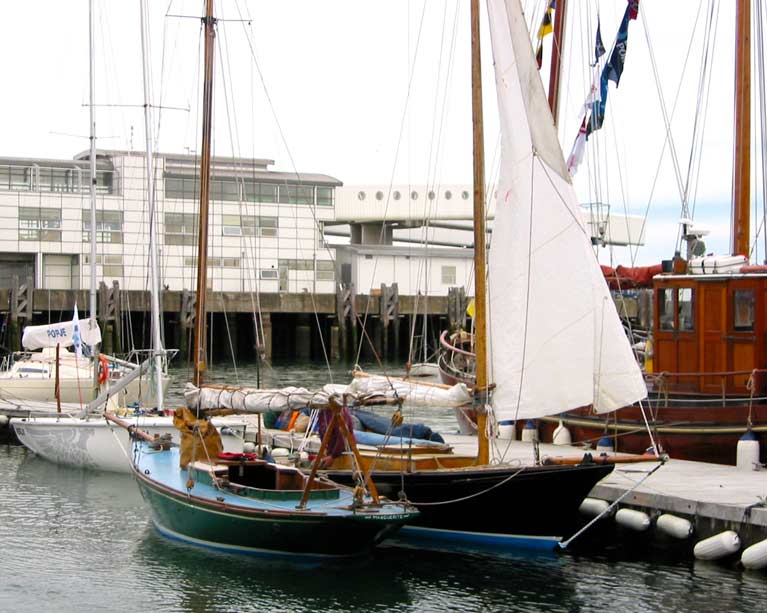 Marguerite and Eithne together at a Woodenboat Rally in Dun Laoghaire in 2003, shortly after the former’s 1999 restoration. Photo: W M Nixon
Marguerite and Eithne together at a Woodenboat Rally in Dun Laoghaire in 2003, shortly after the former’s 1999 restoration. Photo: W M Nixon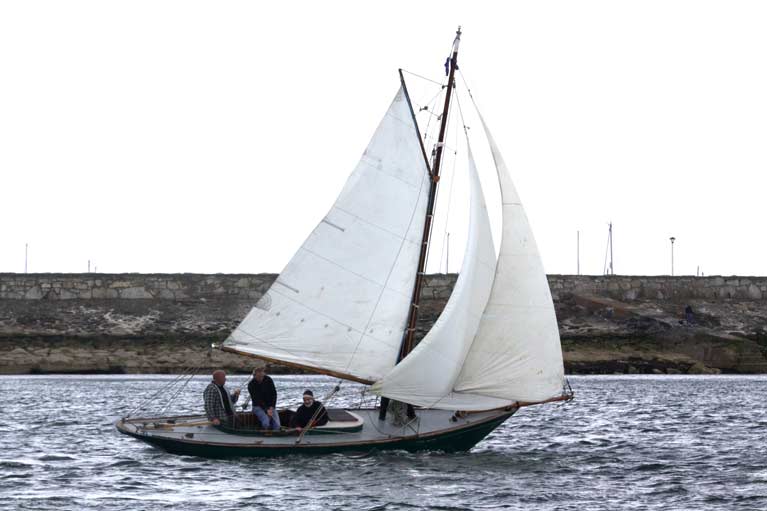 Marguerite as she was in 2013, run as economically as possible and using a mixture of sails. Photo: W M Nixon
Marguerite as she was in 2013, run as economically as possible and using a mixture of sails. Photo: W M Nixon
However, a neat little new engine was installed in order to avail of a tight-fit mooring in the Coal Harbour – not something granted to everyone, but there were many who wanted to help Tim Magennis – and for fifteen years and more, Marguerite in her basically-restored but neatly maintained style was a welcome feature among the newer craft and the utilitarian boats of the Irish National Sailing School in the inner harbour.
Tim Magennis being an enthusiastic member of the Old Gaffers Association, for the season of 2012-2013 he was President of the Dublin Bay OGA when the cream of the OGA fleet came to Dublin Bay as part of their Golden Jubilee, and the little Marguerite gallantly played her role as the flagship of as diverse an assembly of boats as the Liffey has ever seen, with Sean Walsh of the DBOGA becoming the OGA’s President, an international role.
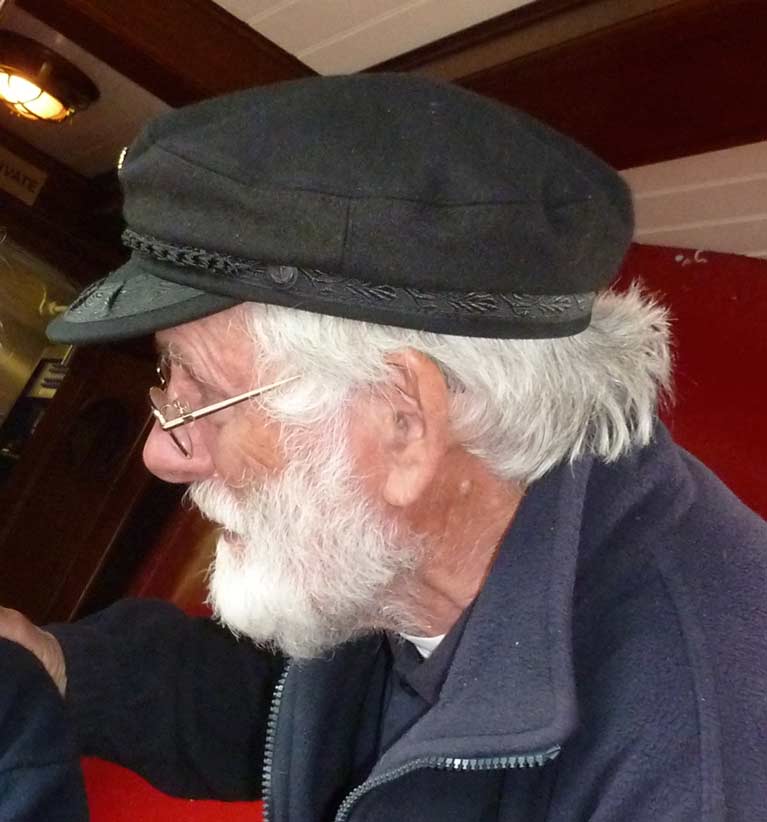 Tim Magennis in his role as President of the Dublin Bay Old Gaffers Association. Photo: W M Nixon
Tim Magennis in his role as President of the Dublin Bay Old Gaffers Association. Photo: W M Nixon
In time, Tim Magennis became an Honorary Member of the OGA, but with his 90th birthday approaching, he was acutely aware that continuing to maintain the Marguerite was becoming too demanding, yet he realised that finding the right people to take her on and maybe give her a full-on classic boat restoration was going to be no easy task.
Looking back now, perhaps it’s a pity that Tim’s main career was in the publicity department of Bord Failte in its developing days, for although he was brilliant at his job, he would have been of great value to the Department of Foreign Affairs, as his skills as a diplomat, persuader and selector of People Who Get Things Done are world class. Having observed the remarkable selection of boats taking part in the OGA Golden Jubilee, he had reckoned that Ian Malcolm of the Howth 17s was in a league of his own in his networking abilities, and at some gaff-rigged gathering he took him aside and asked did he know of anyone who might take on the mission of bringing Marguerite to her true glory, and keeping her there.
Not only is Ian Malcolm one of the main movers in keeping the vintage Howth 17s intact, but he is a committed owner-sailor with the classic Water Wags in Dun Laoghaire, and among their number he knew that Guy Kilroy – who thought so much of the Water Wags that he’d had a completely new boat to the 1900 Maimie Doyle design built by Jack Jones of North Wales - but now was showing the signs, readily recognised by a fellow enthusiast, of needing a much more demanding new project.
And that project was right there with the Marguerite, which always needed work done just to keep her seaworthy, but needed a major job to lift her into classic boat status. By 2017 the outline of an agreement had been worked out between Tim and Guy. But the prospects for the project were made no easier by the fact that Guy and his wife Jackie preferred to have the job done in the Greater Dublin area so that he could keep a close eye on it, for decisions would be needed on an almost daily basis.
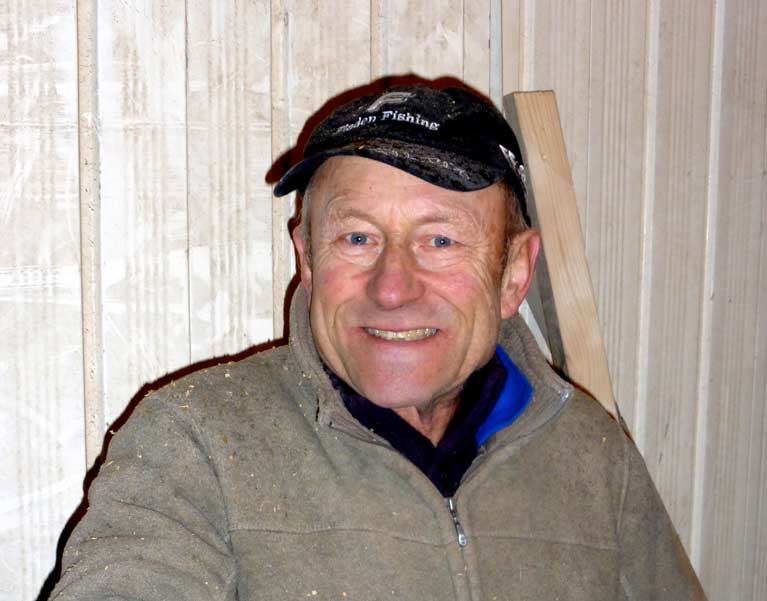 Boatbuilder extraordinaire – Larry Archer is a skilled shipwright in almost every material
Boatbuilder extraordinaire – Larry Archer is a skilled shipwright in almost every material
Fortunately, that star-of-all-trades in boat-building, Larry Archer of Malahide, had secured himself the use of a substantial shed out in the country behind the back of Dublin Airport, a pearl beyond price in a city almost totally devoid of proper marine industry premises. In it, Larry and his right-hand man Paul Fowley were always busy with keeping the Howth 17s in full working order, building a sweet little dinghy to go with the original Asgard in Collins Barracks in order to match the dinghy seen in the famous photo of Erskine & Molly Childers when they were cruising the Baltic in Asgard, and generally getting on with getting things done things.
Bringing Marguerite up to a standard which she had possibly never reached in her long life was right up Larry’s street, and in due course she became the main job in the shed, always gradually progressing even as other more minor jobs came and went.
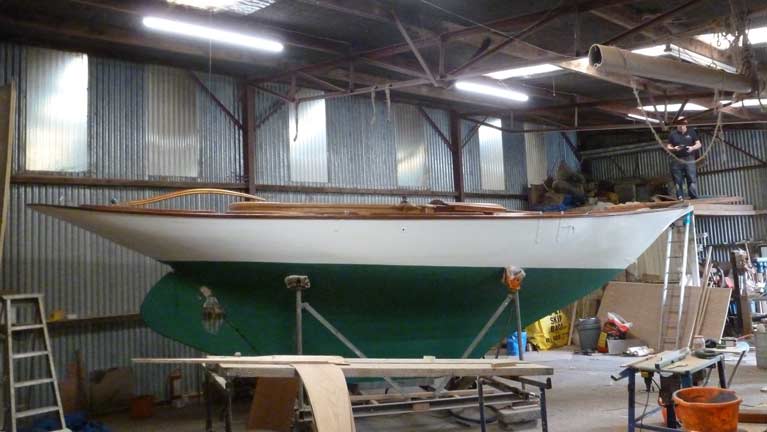 Getting there – Marguerite in the shed “somewhere beyond the airport”, Spring 2019. Photo: W M Nixon
Getting there – Marguerite in the shed “somewhere beyond the airport”, Spring 2019. Photo: W M Nixon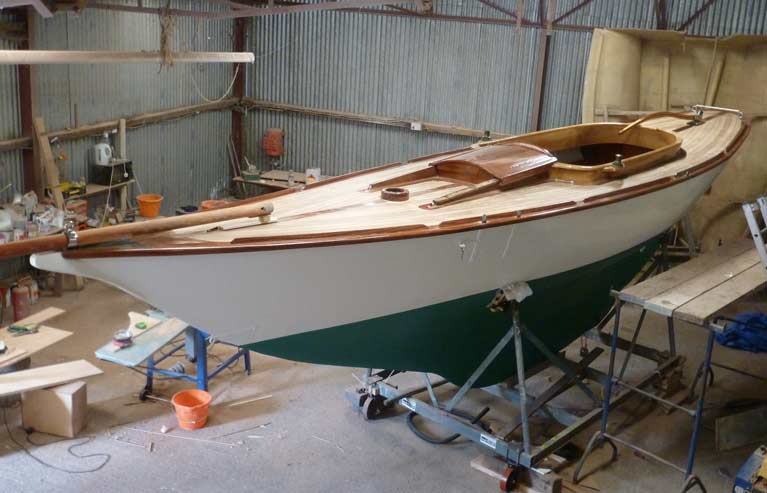 The new deck, hatch and cockpit set the style for the restoration. Photo: W M Nixon
The new deck, hatch and cockpit set the style for the restoration. Photo: W M Nixon
The ambition was to make Marguerite as close as possible to what she had been in 1896. The boat herself was of course available for the basic concept, but despite that high-flown design conference in the Wharf Tavern twenty years ago, there was a feeling that the counter still wasn’t exactly 1896. As for the coachrooof, judging by the only 1890s photo available, the comfortable little cabin as maintained by Tim Magennis was very different from the rather austere virtually flush deck with sliding hatch arrangement indicated in the original.
As well, Marguerite has rather slim sections aft, which greatly helps her speed in light airs, but it meant that the little engine installed in 1999 tended to make her sit a bit by the stern, so Guy Kilroy was very clear that he wanted a new engine installed further forward.
Regarding the cockpit and deck generally, both were to be finished to the highest standards, while in the hull itself, any timber over which there was the slightest question was to be replaced, the ballast keel was to be new bolted, the hint of a clipper bow in the original was to be very definitely retained, and the question of a classic counter – a vague design area with both the restored Eithne and Marguerite - was solved by replicating as far as possible the counter on the Dublin Bay 21s, as good as was ever seen in Dublin Bay.
 At last….inspired by the lines of the Dublin Bay 21, Marguerite finally has a truly classic counter again. Photo: W M Nixon
At last….inspired by the lines of the Dublin Bay 21, Marguerite finally has a truly classic counter again. Photo: W M Nixon
The original gaff sloop rig was to be re-created using old photos, and the sails and spars in classic style were ordered from Paul Robert’s renowned L’Ateliers d’Enfer traditional marine industry and boat-working school complex in Douarnenez in Brittany, where Ian Malcolm was regularly visiting as it was the location for the re-build on the Howth 17 Anita, lost except for her ballast keel in the destruction of the pier-end boat store shed in Howth during Storm Emma in March 2018.
Thus in the end several different places contributed to the re-birth of Marguerite, but the real focus of the action was in the shed in the unlikely setting of that hugely productive agricultural territory west of the airport, and it was summer 2019 before Marguerite could finally be moved to her designated home port of Dun Laoghaire for the final finishing jobs and the sometimes trial-and-error fitting of the new rig.
She’d been finished in pure white topsides with copper-green underside in proper classic yacht style, but it was expected that the boot-top would have to be raised once she was in full day-cruising trim, and as the photos show, such is the case, and she’ll look even better for it.
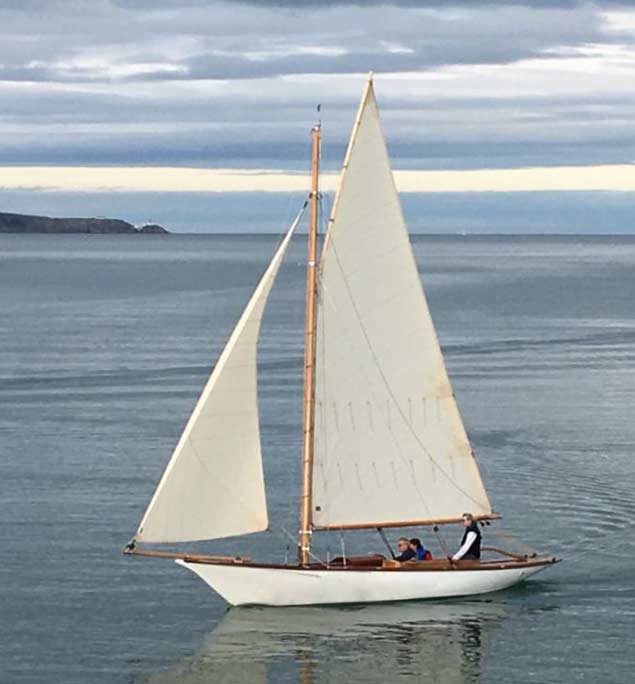 She moves easily through the water with very little fuss, and when the boot-top has been raised as expected, she’ll look even better. Photo: David Williams
She moves easily through the water with very little fuss, and when the boot-top has been raised as expected, she’ll look even better. Photo: David Williams
What with other distraction inevitable in a busy sailing season, it was well into September when Marguerite finally sailed again, and there’s still work to be done. But in due course Dun Laoghaire will have yet another addition to its increasingly varied line-up of true classic yachts, and with two official surveys now under way as to the harbour and harbour area’s future, we can only hope that this increasing interest in classics will be recognized as yet another asset for the harbour as it might be.
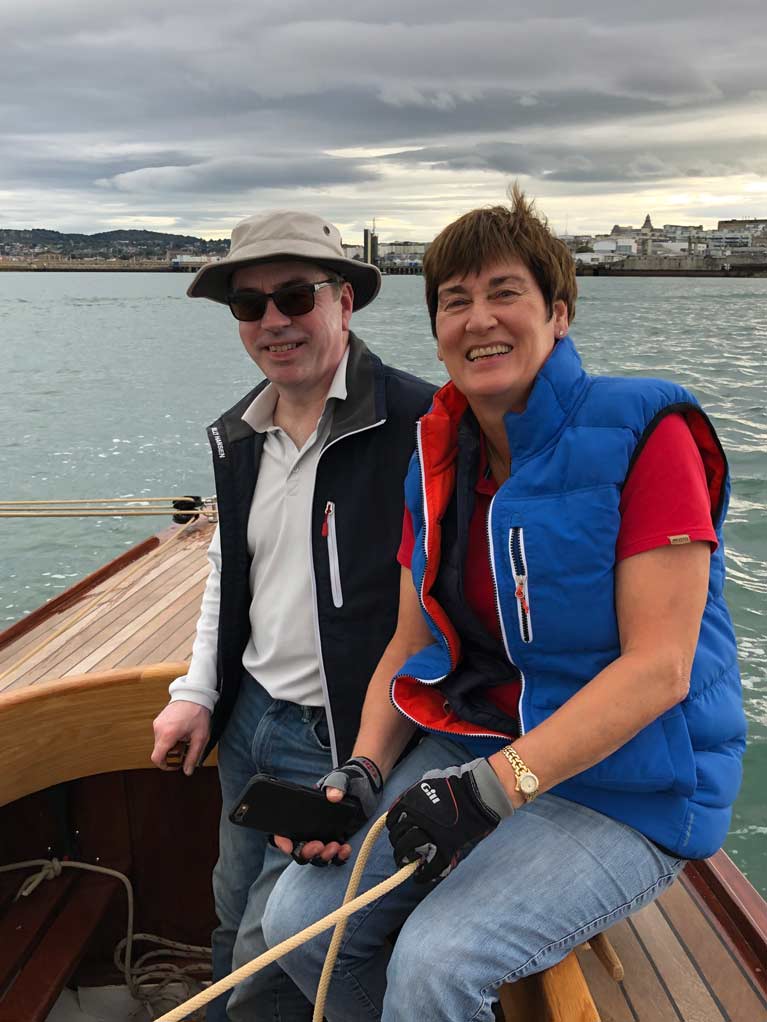 Has it really happened? Guy and Jackie Kilroy on their first sail in their restored 1896-vintage Marguerite. Photo: Ian Malcolm
Has it really happened? Guy and Jackie Kilroy on their first sail in their restored 1896-vintage Marguerite. Photo: Ian Malcolm
For Dun Laoghaire is a classic artificial harbour – indeed, it could probably be best described as a neo-classical harbour. A magnificent structure in itself, it is great augmented by the style and vitality of the three waterfront yacht clubs, each a splendid classical building in its own right.
So although new buildings and new boats will be needed for new and useful additions such as the proposed National Watersports Complex, proper attention should also be paid to the potential for a focal point for classic boats and yachts, and their special requirements.
The historic Water Wags are already a great strength of the harbour scene. The attractive International 12s – once such a feature of the harbour in times past – are making a comeback. The first of the restored Dublin Bay 24s – Periwinkle – is now back in the harbour. The reintroduction of the Dublin Bay 21s is only a matter of time. And the clinker-built Mermaids of 1932 and the IDRA 14s of 1946 also spring to mind for possible revival.
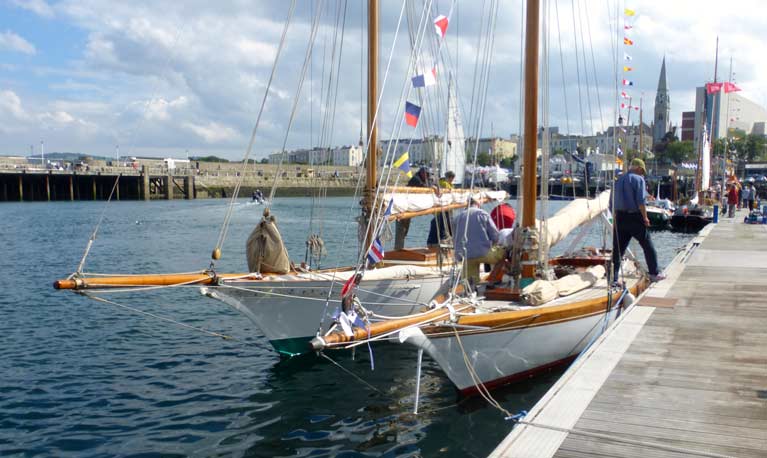 A glimpse of what might be – Peggy Bawn (1894) and Myfanwy (1897) together in Dun Laoghaire in 2017. Photo: W M Nixon
A glimpse of what might be – Peggy Bawn (1894) and Myfanwy (1897) together in Dun Laoghaire in 2017. Photo: W M Nixon
Thus the arrival of Marguerite gives a new dimension to possibilities which were first revealed when Hal Sisk in 2005 brought the superbly-restored 1894-vintage Peggy Bawn back to the harbour which had been her home port since 1919, a dimension which had been emphasised when she got together with the 1897-vintage Myfanwy at the Harbour’s Bicentenary in 2017.
Dun Laoghaire’s past, and the living history of its sailing, become central its future. The story of the restoration of Marguerite, and what she has now become, has been drawn into the Dun Laoghaire Harbour story. And the story of Marguerite and her survival and restoration is a credit to all involved.
After a week of thinking maybe too much about modern and ultra-modern boats contesting the Fastnet Race and Calves Week at Schull, it’s a comforting relaxation to settle gently into contemplation of this weekend’s annual Crunniu na mBad (The Gathering of the Boats) for traditional boats and Irish culture at Kinvara on the west coast, and the championship of the venerable Seventeen Footer class at Howth on the eastern seaboard writes W M Nixon.
Not that the racing, in either case, is a matter of comfortable relaxation. With the Howth Seventeens, it’s the quality of the sport that has kept them going since 1898, unchanged from their original jackyard-topsail-setting design. And with 18 boats in commission this year, the old class is truly fighting fit. That said, the way this weekend’s low pressure area has been behaving, the winds on the east coast have tended to be stronger than in the west, so the Seventeens cancelled their first race scheduled for last night, and start the competition this morning (Saturday).
 Summertime on the East Coast. The Howth Seventeens Isobel (Conor & Brian Turvey) and Leila (Roddy Cooper) beating into the sea breeze as they approach The Stack at the east point of the island of Ireland’s Eye off Howth. The stack is one of Ireland’s more recent gannetries – the first pair of gannets nested there in 1989, and now the colony is so strong it has spread to the nearby island despite the threat of rats, while a new sub-colony has been formed on a rock on the north side of Lambay six miles away. Photo: Tom Ryan
Summertime on the East Coast. The Howth Seventeens Isobel (Conor & Brian Turvey) and Leila (Roddy Cooper) beating into the sea breeze as they approach The Stack at the east point of the island of Ireland’s Eye off Howth. The stack is one of Ireland’s more recent gannetries – the first pair of gannets nested there in 1989, and now the colony is so strong it has spread to the nearby island despite the threat of rats, while a new sub-colony has been formed on a rock on the north side of Lambay six miles away. Photo: Tom Ryan
Cruinnui na mBad is a much more complex affair organised by Dr Mick Brogan and his team, an extraordinary interaction between sea and land which was started by the late Tony Moylan in 1979 – making this its 40th Anniversary – to commemorate and celebrate the fact that in times past, and particularly in August, the traditional Hookers of Connemara would sail right up Galway Bay and into the sweet natural harbour of Kinvara carrying turf.
Kinvara is at the heart of a relatively lush area which is very different from Connemara, and thus lacking in readily-available natural supplies of the traditional fuel. So the voyage there with a useful consignment of winter warmth had a natural harmony, and of course, the safe arrival and discharge of the cargo was something for celebration in the Pier Head bar and other hostelries in the popular little village by sailors and locals alike.
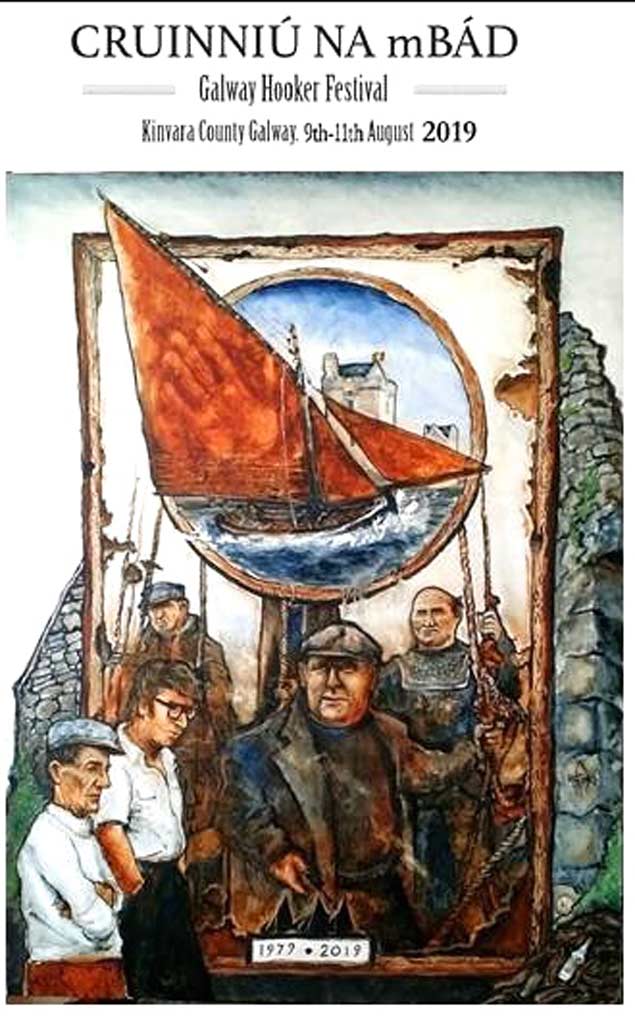 This weekend sees the fortieth annual Cruinnui na mBad – the late Tony Moylan (second left) was the main mover in founding it back in 1979
This weekend sees the fortieth annual Cruinnui na mBad – the late Tony Moylan (second left) was the main mover in founding it back in 1979
These days, the useful motorway from Dublin to Galway, plus the continuing strength of trad-boat enthusiasm in both Connemara and in Galway city itself, has seen a resurgence of life in the traditional sailing boats of the west. The convenience of the motorway means that any Galway hooker enthusiast living in the outskirts of the greater Dublin area can be with their special craft on Galway Bay as quickly as the boat could be reached at a Dun Laoghaire, Poolbeg or Howth harbour berth, and needless to say berthing charges in the west are a very different proposition – indeed, in some of the more picturesque places, the traditional boats should be paid appearance money…….
Certainly, it’s the massed appearance of the Galway Hookers in all sizes which is the making of the Kinvara festival, even if the music and dancing and singing and festivities seem to grow with every year. The time-honoured ceremony of discharging the turf cargo is completed on the quay in the heart of the village today at 4.0pm, while as the tide make towards high water the racing gets underway today at 2.30pm at Parkmore for the Gleoiteog Race, and for the bigger boats at 2.0 pm tomorrow (Sunday), starting and finishing almost in the heart of town.
 The Galway Hookers may be the historic representatives of an ancient type, but they are hard raced nevertheless. Photo: Paul Harris
The Galway Hookers may be the historic representatives of an ancient type, but they are hard raced nevertheless. Photo: Paul Harris
Last year in the four divisions, the winner of the Bad Mor (big boat) Class was the Tonai, skippered by Mairtin O’Brien, while the slightly smaller Leath Bad (half boat) class went to Croi na Cladaigh, built in 2012 in Galway city by Peter Connolly, and raced on the day by the legendary Colie Hernon.
John Flaherty sailing the Gleoitog Mor Naomh Cailin was the winner in that class, while the small boats of the Gleoitog division were led in by Colie og Hernon. All this was only part of the sport afloat, as the seaweed raft racing took place right in the harbour, and simply staying afloat was as important as winning.
 Tank-tested design for a seaweed raft……..Photo Pierce Purcell Jnr
Tank-tested design for a seaweed raft……..Photo Pierce Purcell Jnr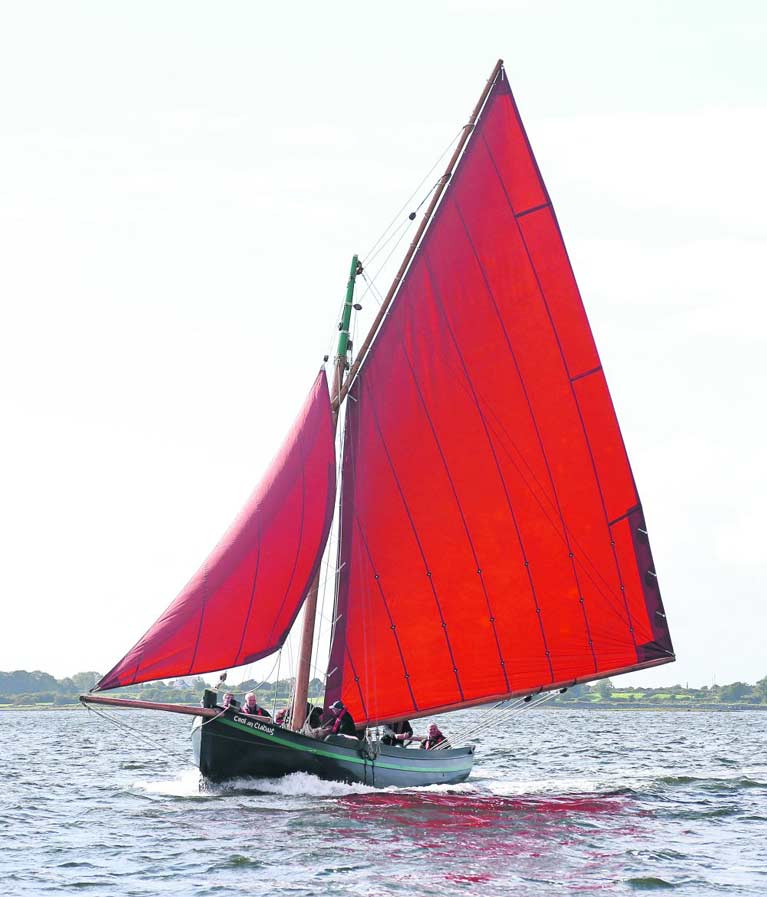 The leath bad Croi na Cladaig (Peter Connolly) was raced by Colie Hernon to the class win in 2018
The leath bad Croi na Cladaig (Peter Connolly) was raced by Colie Hernon to the class win in 2018
With this weekend’s volatile weather, several boats from Connemara had already made the prudent decision to get themselves to Kinvara before the current low-pressure system began to do its worst, and as of last night there were already nearly 30 of those classic hulls to be seen at the quay.
As it happens, the low-pressure area itself had filled a bit over the land, but as ever there always a vicious twist or two in the tail in the form of sudden squalls and maybe thunderstorms as the system re-gathers strength over the North Sea. But nevertheless the unusual situation has developed where there may be more wind on the east coast than in the west, so all being well the racing programme will be completed at Kinvara in a westerly today, and a moderate to fresh northwest to north breeze tomorrow
Whatever the outcome, the underlying trend in the Connacht traditional boat movement is healthy, and the latest piece of good news is that the famous True Light, after quietly decaying for a number of years, has been bought by a quartet of new owners, and they’re bringing her to Galway city itself for a complete restoration in the same place as the much-admired Gentle Ann was given new life.
 The timeless image of the west – boats of the Bad Mor class racing at Kinvara
The timeless image of the west – boats of the Bad Mor class racing at Kinvara
 High summer in Kinvara – Dungaire Castle in foreground, and the village itself beyond, with the hills and mountains of The Burren in the distance
High summer in Kinvara – Dungaire Castle in foreground, and the village itself beyond, with the hills and mountains of The Burren in the distance
With the Howth Seventeens all being based in the one harbour and most owners living almost within walking distance, the decision to cancel the first race last night was not a big deal. So for now we should enjoy some unusual photos of these little boats taken by Tom Ryan who - in addition to a day job - is Assistant Cox’n of Howth Lifeboat, and is also an amateur photographer (using the moniker Stormy Photos) who enjoys finding unusual shots out on his RIB or up on the cliffs in Howth.
It takes a fresh eye to remind us of what an odd and exotic place is the Howth Peninsula, for inevitably we sometimes tend to take it for granted, yet all these images were obtained within a couple of kilometres of where I’m sitting writing this.
 The Howth 17s in close formation – Aura (No 7, Ian Malcolm, foreground) has been winning in Dublin Bay, but the Masseys and Mikey Twomey in Deilginis (No 11, right) have been winning in home waters, while success has also been recorded by Brian and Conor Turvey in the silver-hulled Isobel (No 19), Peter Courtney in the yellow-hulled Oonagh (No 17), and John Curley and Marcus Lynch in the white-hulled Rita (No 1). Photo: Tom Ryan
The Howth 17s in close formation – Aura (No 7, Ian Malcolm, foreground) has been winning in Dublin Bay, but the Masseys and Mikey Twomey in Deilginis (No 11, right) have been winning in home waters, while success has also been recorded by Brian and Conor Turvey in the silver-hulled Isobel (No 19), Peter Courtney in the yellow-hulled Oonagh (No 17), and John Curley and Marcus Lynch in the white-hulled Rita (No 1). Photo: Tom Ryan
And as for the Howth Seventeens racing, the word is that Ian Malcolm with the 1898-built Aura has been winning when it involves going south of the Baily, as he topped the class in the VDLR19 Regatta in Dublin Bay and also won in the annual race to Clontarf for the recent Clontarf Y&BC “At Home”.
 Hugging the cliffs to beat the tide. As the Clontard Y&BC At Home is held in a tidal venue, the Howth 17s have to push the tide to get there, so they go close in under the cliffs of Howth Head, and then they have the plug the new ebb to get home again. Photo: Tom Ryan
Hugging the cliffs to beat the tide. As the Clontard Y&BC At Home is held in a tidal venue, the Howth 17s have to push the tide to get there, so they go close in under the cliffs of Howth Head, and then they have the plug the new ebb to get home again. Photo: Tom Ryan
But in home waters north from the harbour, defending champion Deilginis (built 1907, Massey family & Mikey Twomey) has been setting the pace, but well challenged by Conor and Brian Turvey in Isobel (built 1988), Peter Courtney in the 1909-built Oonagh, and Marcus Lynch and John Curley in Rita, another of the original 1898 boats.
Although there seems to be an increase in the use of the Howth Seventeens for day sailing as the young tearaways of yesterday become parents and hope to get their own young children to enjoy sailing as much as they do, it is still the racing which is the cement which holds the class together At 121 years old and still going strong, it’s quite something.
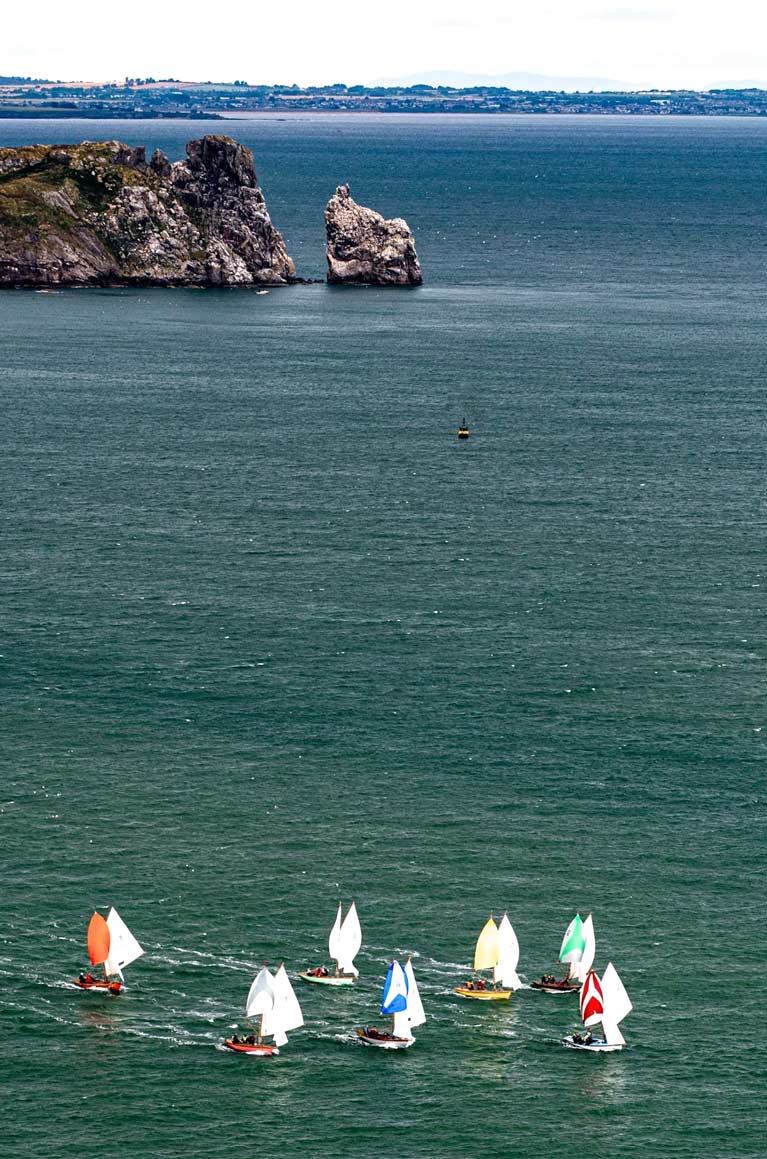 Still racing where they’ve been racing for 121 years – the Howth 17s with Ireland’s Eye beyond. Photo: Tom Ryan
Still racing where they’ve been racing for 121 years – the Howth 17s with Ireland’s Eye beyond. Photo: Tom Ryan
Built as a Sailing Boat – the Unique Free State Fishing Boat
In recent podcasts I’ve reported on the Cork Harbour T Boats, a Class now extinct apart from the restored original boat, which I highlighted last week here; the successful revival of the Rankins; the restoration underway of the gaff-cutter Lady Min and followed the marvellous restoration of the Ilen, the last Irish trading ketch, now in Greenland's waters.
That was carried out at Liam Hegarty’s boatyard in Oldcourt, Skibbereen, on the River Ilen. It’s not far from there to Baltimore, where that port, a major sailing location these days, was a major builder of fishing boats and Skinner’s yard well-known.
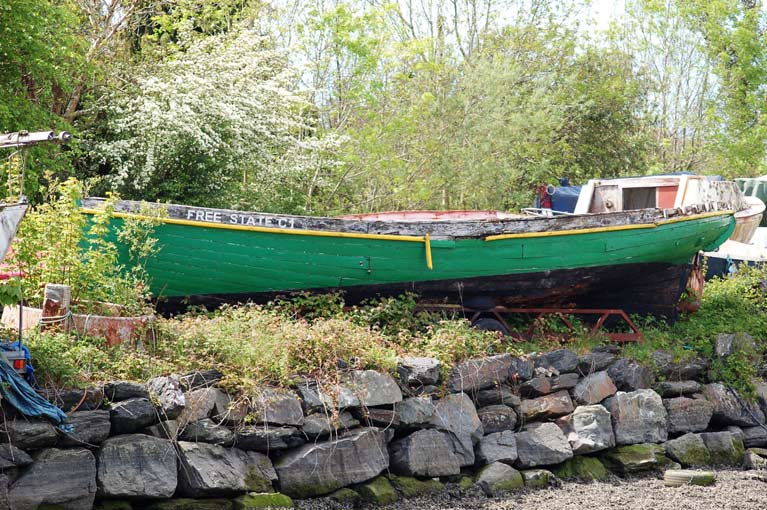 Free State C1 at Hegarty's Boatyard in Oldcourt Photo: Tom MacSweeney
Free State C1 at Hegarty's Boatyard in Oldcourt Photo: Tom MacSweeney
Back at Liam Hegarty’s yard, I came across a boat which had been built at Skinner’s and whose connections are historic to the founding of the Irish Republic.
Built in the style of a sailing boat, it became the first-ever boat to be registered as a fishing boat in County Cork, with a name that is outstanding – FREE STATE C1. So named because administrators of the emergent Irish State in 1922 apparently would not register it in Irish! So the family made their point with the unique name.
This is a story that has to be heard in the telling and was told to me by Eoin Ryan, himself a seafarer, whose family owns the boat that was “a super business venture in her time,” as he put it and also the first fishing boat, with sailing boat lines, built with an engine in place.
Listen to the podcast below
Crosshaven Trad Sail 2019: Photo Gallery
This year's Crosshaven Trad Sail that that concluded in Cork Harbour today had a packed programme of festival events around the historic boat regatta writes Bob Bateman.
As Afloat previously reported, the celebrations begin at The Oar Bar on Friday evening with live music upstairs from 8 pm.
Racing for all types of craft began at 2 pm and included many traditional dinghy types including a National 18 and a good fleet of Rankin dinghies with the annual Parade of Sail for spectators at 4 pm.
Sunday racing was cancelled due to a weather alert.

Images from today's sailing by Bob Bateman are below
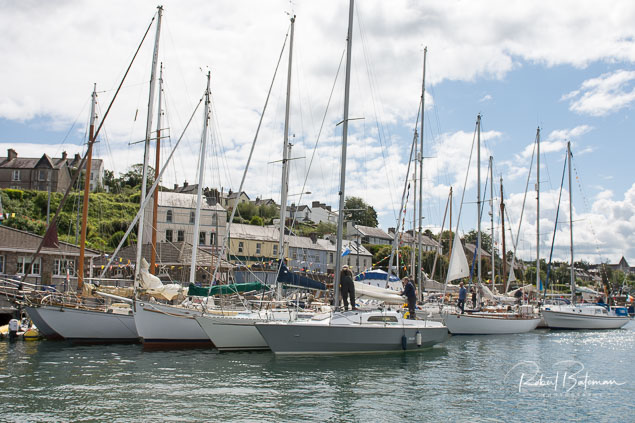
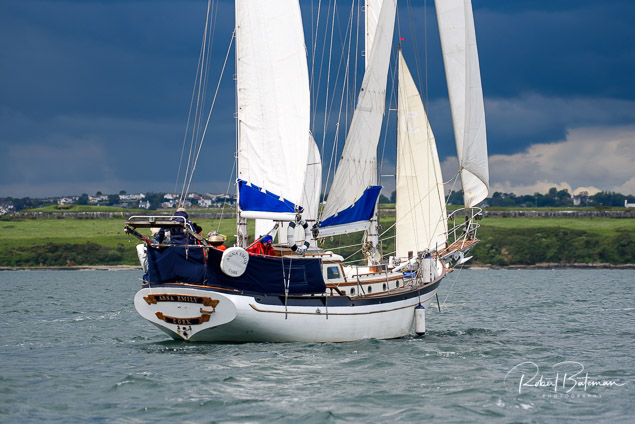
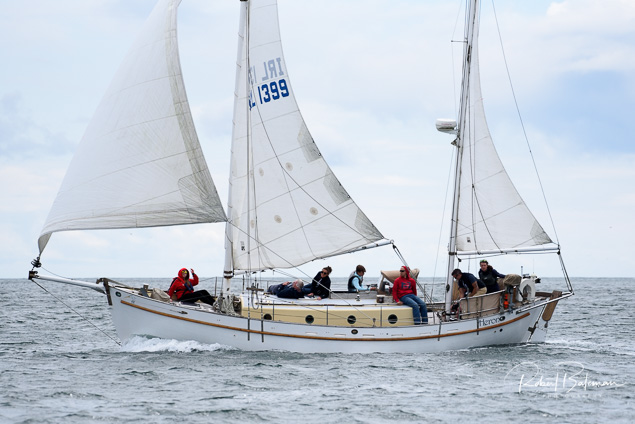
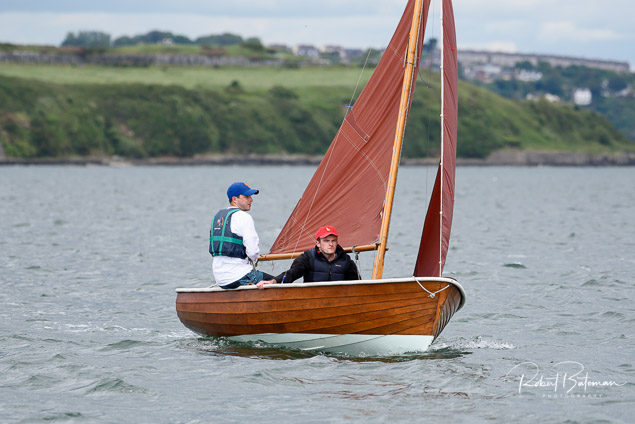
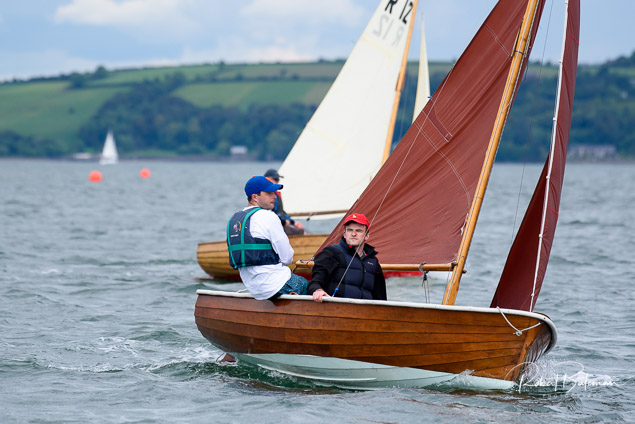
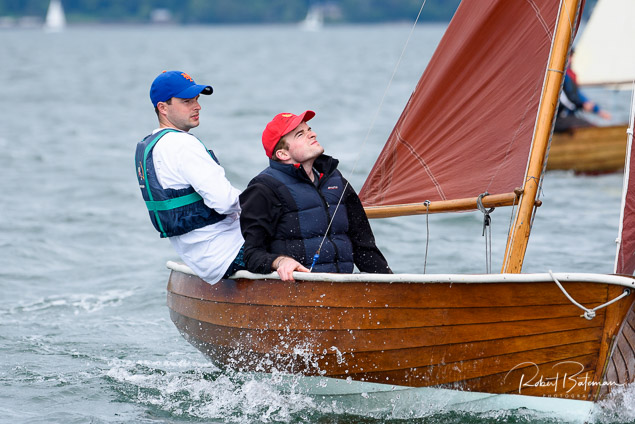
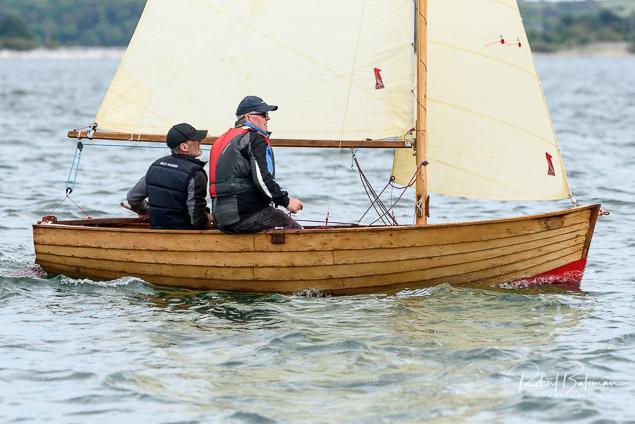
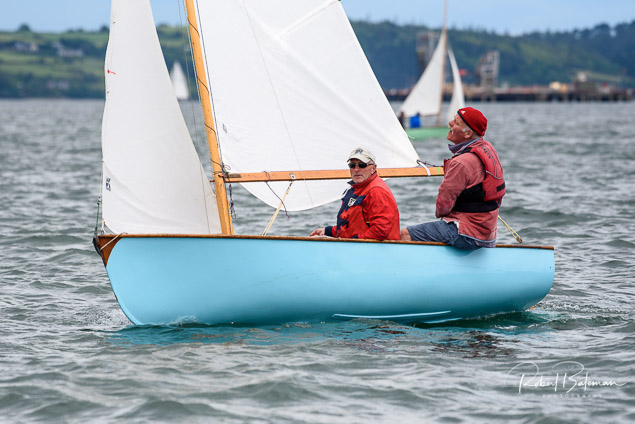
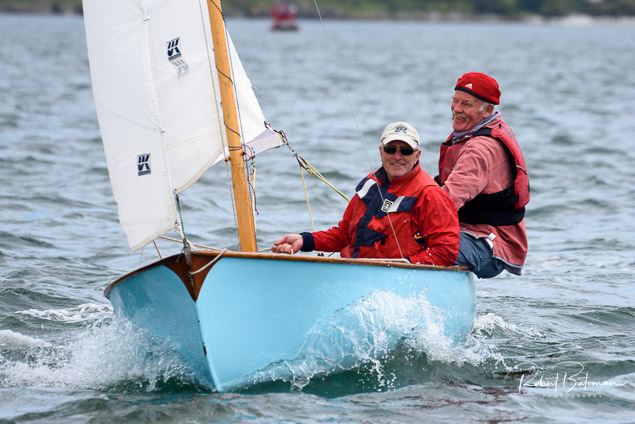

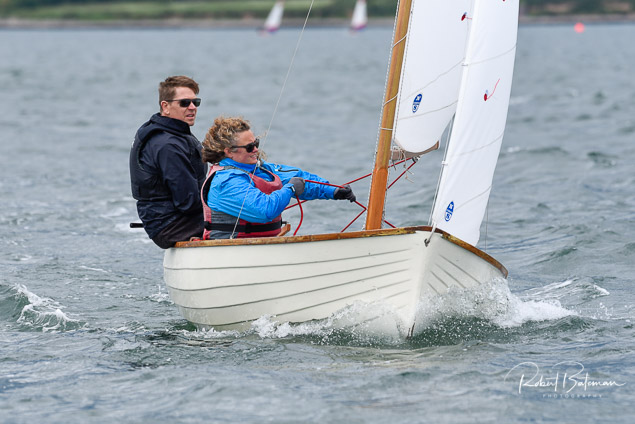
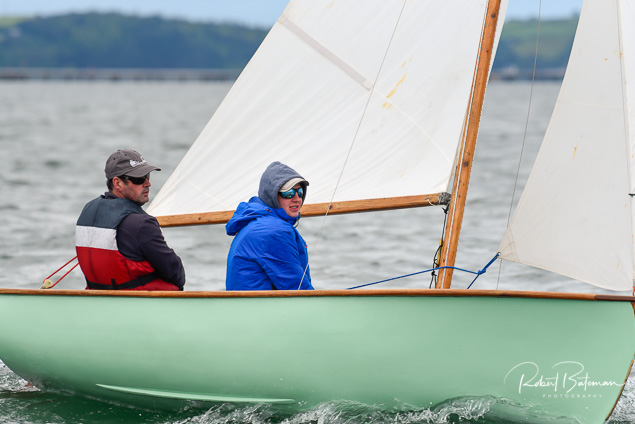
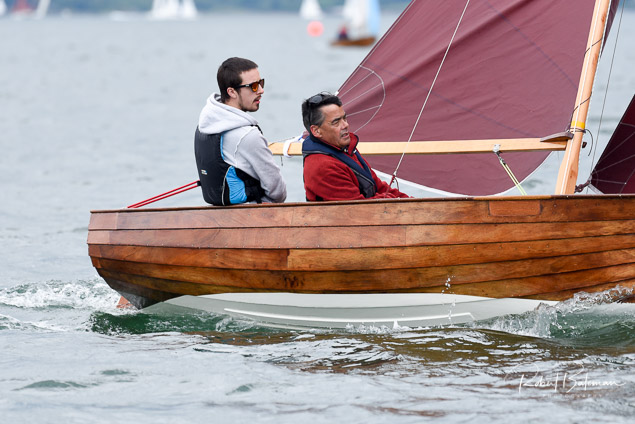
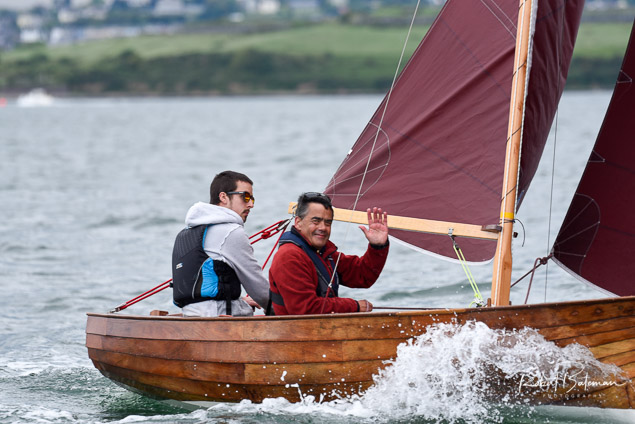

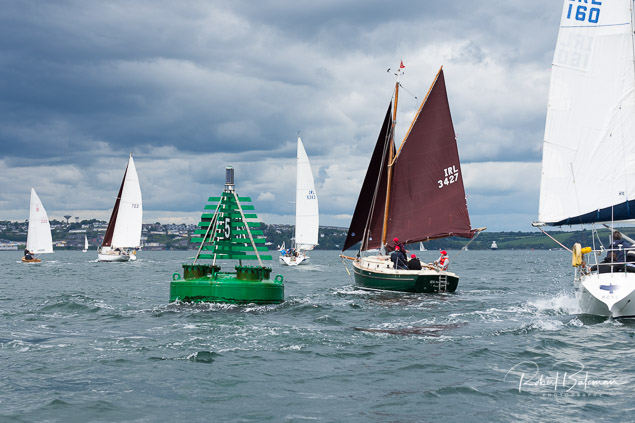
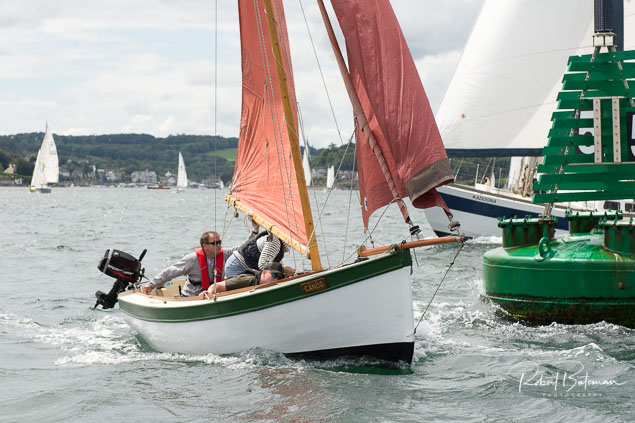


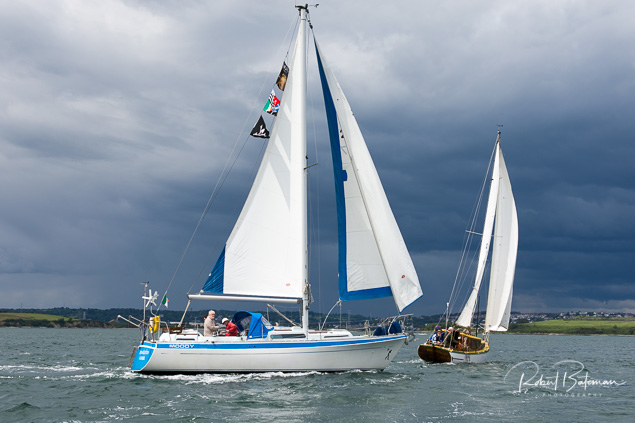

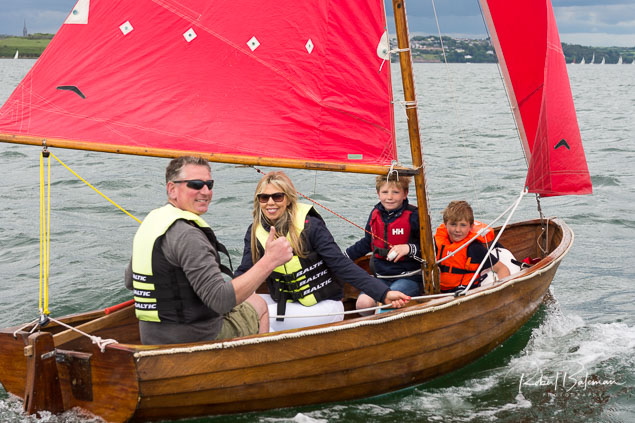

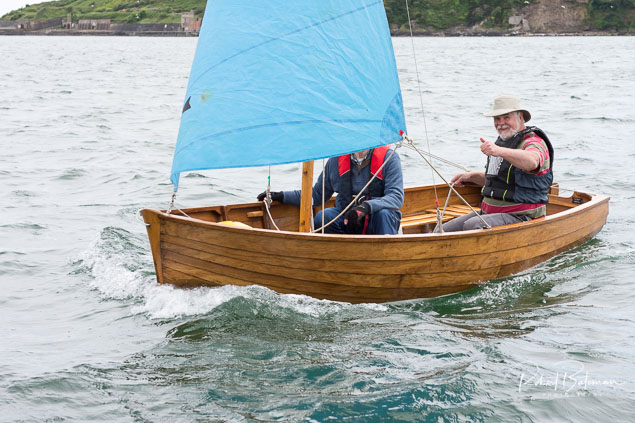

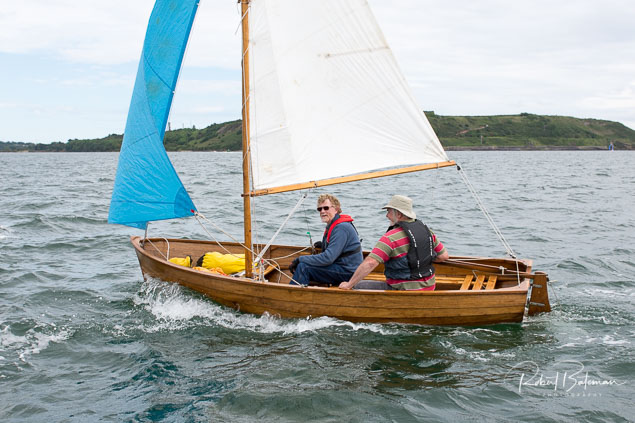

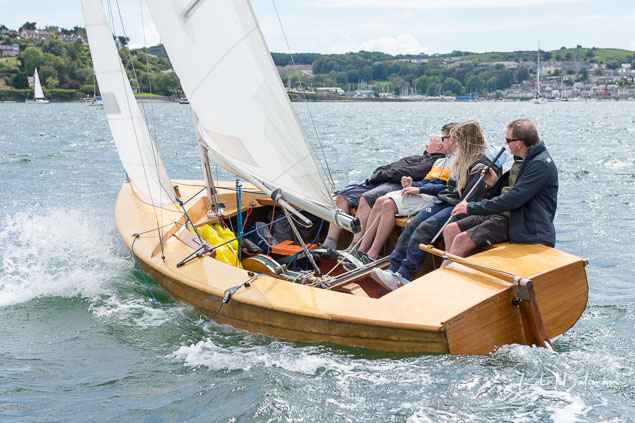

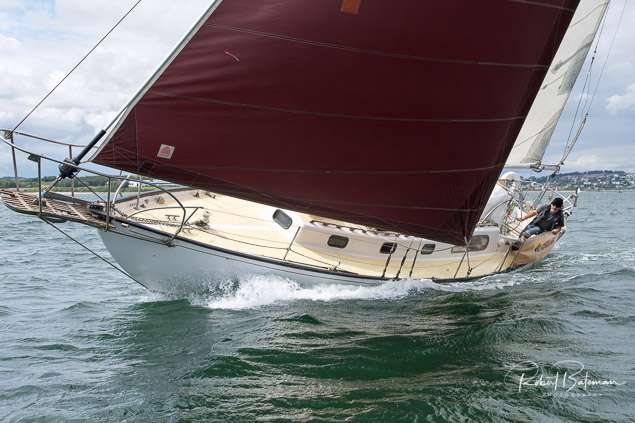
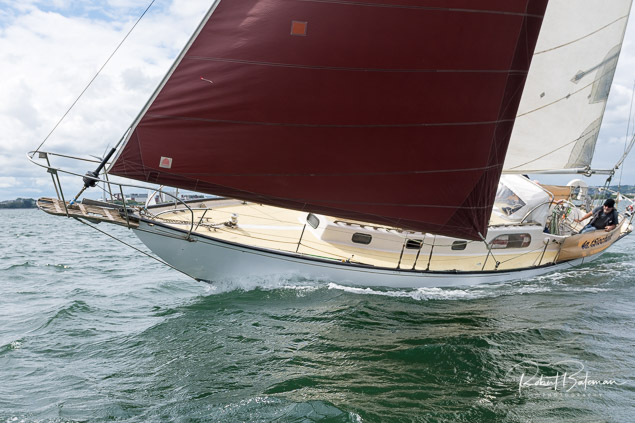

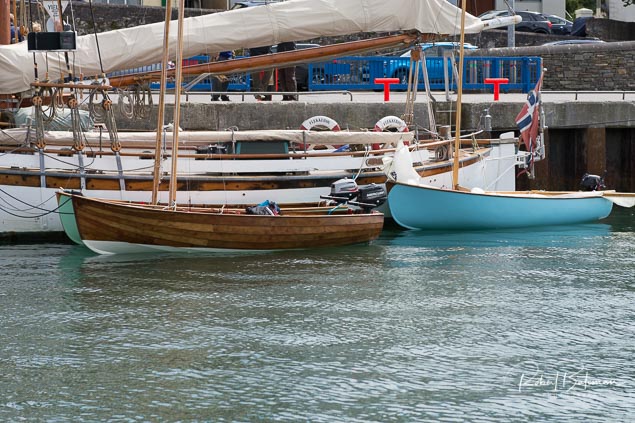
Baltimore’s the Place for the Best in Traditional Wooden Boats & the Great Folk Who Sail Them
West Cork is as much a state of mind as it is a place writes W M Nixon. And when you’re in its bright and cheerfully breezy sailor’s capital of Baltimore, the annual Maytime Festival of Wooden Boats is something very special. Last weekend, they gathered from near and far for a diverse programme afloat, mixed with everything from Boat Building Competitions and Craftwork Shows to Art Exhibitions ashore. It was quite a party, and we’ll let the photos speak for themselves. That said, where on earth did one of the Cork currachs get the name of “Magic Brat”…?
 Saoirse Muirreann, Lobsterboat, Cormac Levis, followed by An Rún, Mackerel Boat, owner Nigel Towse, skipper Ian Wright. Photo: Robbie Murphy
Saoirse Muirreann, Lobsterboat, Cormac Levis, followed by An Rún, Mackerel Boat, owner Nigel Towse, skipper Ian Wright. Photo: Robbie Murphy Saoirse Muirreann, Lobsterboat, Cormac Levis with Hanora, Lobsterboat, Nigel Towse, in background off Sherkin Island. Photo: Robbie Murphy
Saoirse Muirreann, Lobsterboat, Cormac Levis with Hanora, Lobsterboat, Nigel Towse, in background off Sherkin Island. Photo: Robbie Murphy
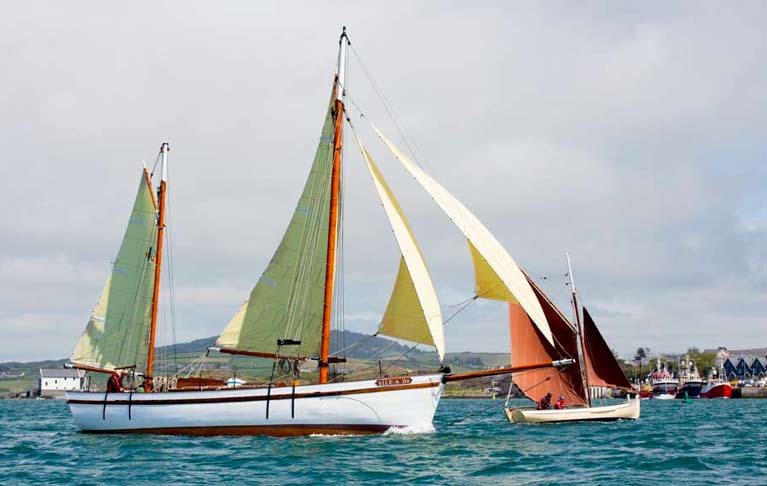 Sile a Do, gaff ketch built Hegarty’s, owner Leo McDermott (left) with Saoirse Muirreann (Lobster Boat, Cormac Levis) Photo: Robbie Murphy
Sile a Do, gaff ketch built Hegarty’s, owner Leo McDermott (left) with Saoirse Muirreann (Lobster Boat, Cormac Levis) Photo: Robbie Murphy Guillemot, built Skinners, Baltimore, 1893, Brian Marten. Photo: Robbie Murphy
Guillemot, built Skinners, Baltimore, 1893, Brian Marten. Photo: Robbie Murphy
 Fionn, Lobsterboat, skipper Rob O’Leary, and Lively, designed, built and skippered by James Baker of Penryn, Falmouth, Cornwall. Photo: Robbie Murphy
Fionn, Lobsterboat, skipper Rob O’Leary, and Lively, designed, built and skippered by James Baker of Penryn, Falmouth, Cornwall. Photo: Robbie Murphy Canóg, built by late George Bushe 1997, skipper Mark Bush, with Galway Hooker An Faoilean, Pat Tanner, built 1912. Photo: Robbie Murphy
Canóg, built by late George Bushe 1997, skipper Mark Bush, with Galway Hooker An Faoilean, Pat Tanner, built 1912. Photo: Robbie Murphy
 Pilot Race, with Rogaire Dubh Currach putting pilot onboard Lively for race back into Baltimore (winner of the Pilot Race) Photo: Robbie Murphy
Pilot Race, with Rogaire Dubh Currach putting pilot onboard Lively for race back into Baltimore (winner of the Pilot Race) Photo: Robbie Murphy
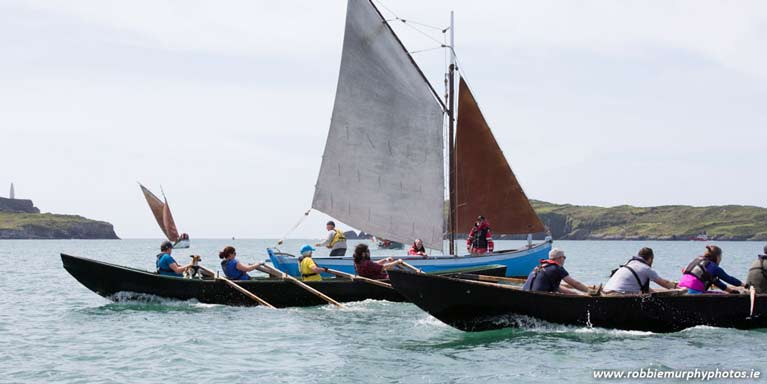 Racing Maitheal Mara Naomhogs with the blue-hulled Mary Colette Lobsterboat, Micheal O Croalaoi & John Colleran, An Rún Mackerel Boat, owner Nigel Towse, skipper Ian Wright in distant left. Photo: Robbie Murphy
Racing Maitheal Mara Naomhogs with the blue-hulled Mary Colette Lobsterboat, Micheal O Croalaoi & John Colleran, An Rún Mackerel Boat, owner Nigel Towse, skipper Ian Wright in distant left. Photo: Robbie Murphy
 Currach and Naomhogs racing for Baltimore, after rowing from Skibbereen down the Ilen River. Photo: Robbie Murphy
Currach and Naomhogs racing for Baltimore, after rowing from Skibbereen down the Ilen River. Photo: Robbie Murphy
 Fionn, Lobsterboat, built in Hegarty’s 1999, first of new-build Lobsterboats, owner Mary Jordan and the late Colm O Cuilleanain, sailed Rob O’Leary, Oisin Creagh Photo: Martyn Blair
Fionn, Lobsterboat, built in Hegarty’s 1999, first of new-build Lobsterboats, owner Mary Jordan and the late Colm O Cuilleanain, sailed Rob O’Leary, Oisin Creagh Photo: Martyn Blair
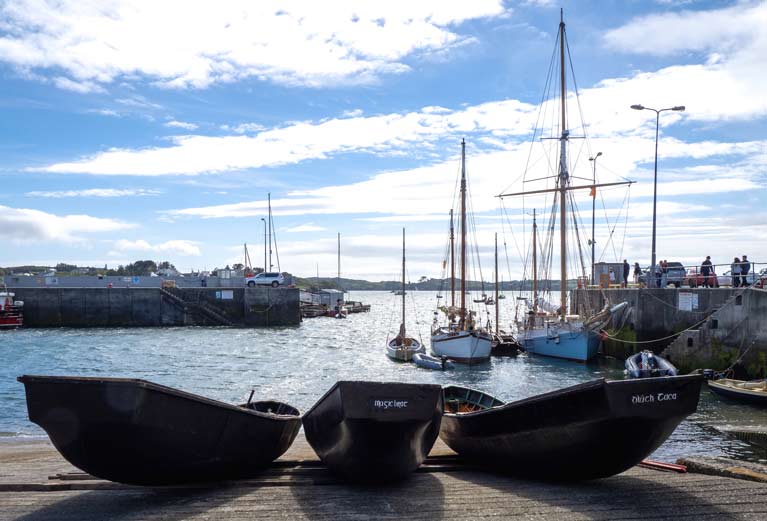 After the racing, currachs Rinceoir na Greine, Magic Brat and Dlúth Taca on slip, with Sile a Dó, An Faoilean and AK Ilen at the pier. Photo: Martyn Blair
After the racing, currachs Rinceoir na Greine, Magic Brat and Dlúth Taca on slip, with Sile a Dó, An Faoilean and AK Ilen at the pier. Photo: Martyn Blair
 Around the mark under the Beacon, Lively, James & Kate Baker (and their two children) followed by Mary Colette, Lobsterboat, Micheal O Croalaoi & John Colleran, Hanora, original Lobsterboat, Nigel Towse, and Fionn (Lobsterboat) in the distance. Photo: Martyn Blair
Around the mark under the Beacon, Lively, James & Kate Baker (and their two children) followed by Mary Colette, Lobsterboat, Micheal O Croalaoi & John Colleran, Hanora, original Lobsterboat, Nigel Towse, and Fionn (Lobsterboat) in the distance. Photo: Martyn Blair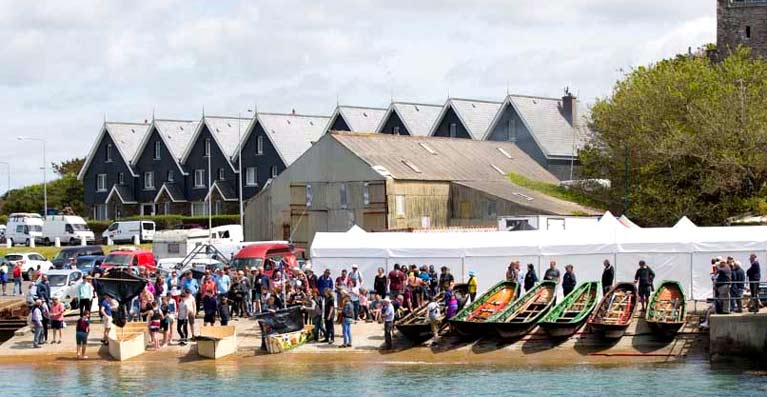 Getting ready to start the ‘New Boats’ race on Sunday, They were built on Saturday, with each team getting the same materials, including black plastic for sails. The boats have to row and sail a course if they stay afloat – it’s a highlight of the Festival The Meitheal Mara boats from Cork city are on the right. Photo: Robbie Murphy
Getting ready to start the ‘New Boats’ race on Sunday, They were built on Saturday, with each team getting the same materials, including black plastic for sails. The boats have to row and sail a course if they stay afloat – it’s a highlight of the Festival The Meitheal Mara boats from Cork city are on the right. Photo: Robbie Murphy
Baltimore Wooden Boat Festival Welcomes Restored Ilen Home to Her Birthplace After Historic Dublin Visit
Three million euro - every bit of €3 million writes W M Nixon. That’s what the late Theo Rye, internationally-recognised expert on the restoring and re-building of classic and traditional craft, reckoned that breathing new life into Ireland’s historic 56ft trading ketch Ilen would have cost – at the minimum - if the project had been awarded on a fully professional basis to some comprehensively equipped, properly qualified and economically efficient specialist boatyard in the heartlands of the top end of boat-building skills, in places such as The Netherlands, or at select yards around the Solent, or somewhere up in Denmark.
However, the restoration of the 1926-built Ilen, in a joint effort by the Ilen Boat-building School in Limerick and Liam Hegarty’s Oldcourt Boatyard near Baltimore, has certainly produced a fully restored little ship which exudes quality and authenticity. But thanks to special efforts by all involved, there is no way that the cost has been remotely near that jaw-dropping figure of €3 million.
Yet while the sums have been much more manageable, every cent of it has had to be secured from one source or another, and by this stage Gary Mac Mahon of Limerick – the inspiring overall promoter of the Ilen ideal – can probably fill out grant applications and benevolent funding proposals in his sleep.
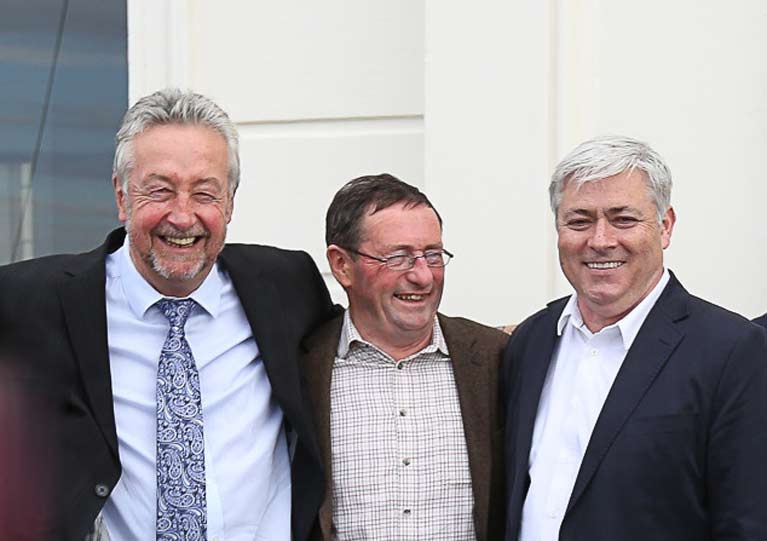 Captain Gerry Burns, shipwright Liam Hegarty and Ilen Project Director Gary MacMahon at the Ilen reception in the Royal Irish YC. Photo: Dermot Lynch
Captain Gerry Burns, shipwright Liam Hegarty and Ilen Project Director Gary MacMahon at the Ilen reception in the Royal Irish YC. Photo: Dermot Lynch
Now, however, the fact that Ilen is in full seagoing commission and properly certified - following her annual inspection by official specialists in Baltimore a fortnight ago - gives people something very tangible to grasp when support is sought.
Rather than the high-flown but inevitably vague talk of times past, and thoughts of increasing respect for Ireland’s sometimes hidden maritime traditions while also honouring the memory of Conor O’Brien whose seafaring achievements directly resulted in Ilen being built in the first place, we now have something real. A proper little ship with which we can all identify. A little ship which nevertheless still needs a steady flow of real money to keep up the good work of adding interest to international school projects, implementing programmes like Sailing Into Wellness, and giving extra meaning to environmental campaigns.
Thus last weekend’s extended visit to Dublin, with target points for shoreside interactions with well-wishers at Poolbeg Yacht and Boat Club in the Liffey, the Royal Irish Yacht Club in Dun Laoghaire, and the heart of Howth Harbour during the annual Prawn Festival, were all occasions with multiple purposes.
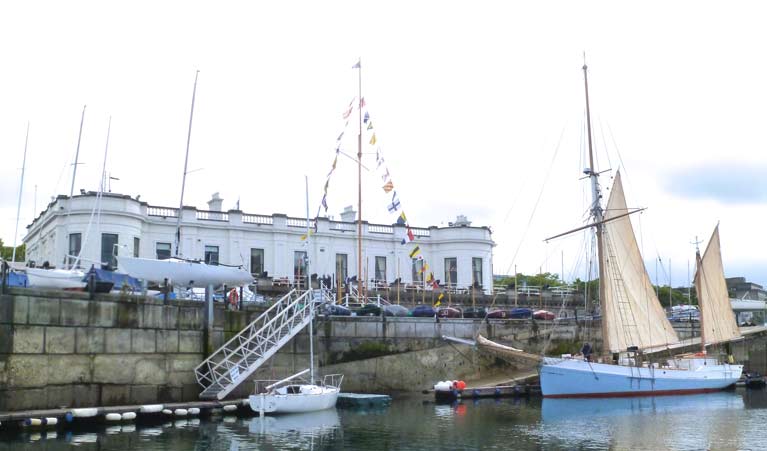 When the Ilen arrived at her berth at the RIYC, it had only recently stopped raining, but by the time the reception got underway, the sun was shining. Photo: W M Nixon
When the Ilen arrived at her berth at the RIYC, it had only recently stopped raining, but by the time the reception got underway, the sun was shining. Photo: W M Nixon
At its most basic, there was the opportunity for people who had a vague feeling of goodwill towards the ship to actually see her and go aboard. Then for those who knew something of what the restored Ilen really meant, there was an opportunity to inspect and wonder at the quality of the restoration, and the skills of creative design which have been used to turn a little freight and ferry ship into a proper long distance voyager with comfortable crew accommodation, yet with enough space to be a floating classroom.
This weekend, Ilen is the star of the annual Baltimore Wooden Boat Festival. But while many memories are vivid from last weekend’s time in Dublin, there’s no doubt the highlight was the re-launch ceremony at the Royal Irish Yacht Club in Dun Laoghaire, a club with which the Foynes Island sailor Conor O’Brien from County Limerick had special links.
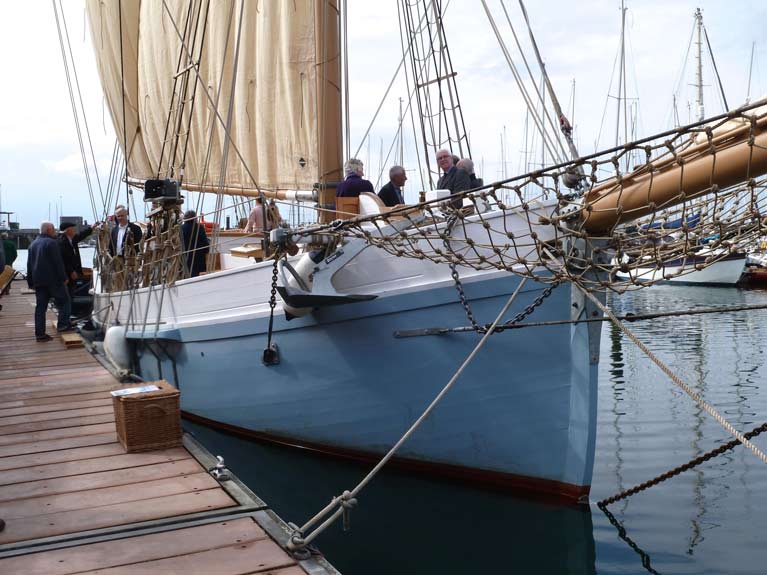 A seriously traditional ship – Ilen at the RIYC berth with the sun coming through and visitors beginning to flock on board. Photo: W M Nixon
A seriously traditional ship – Ilen at the RIYC berth with the sun coming through and visitors beginning to flock on board. Photo: W M Nixon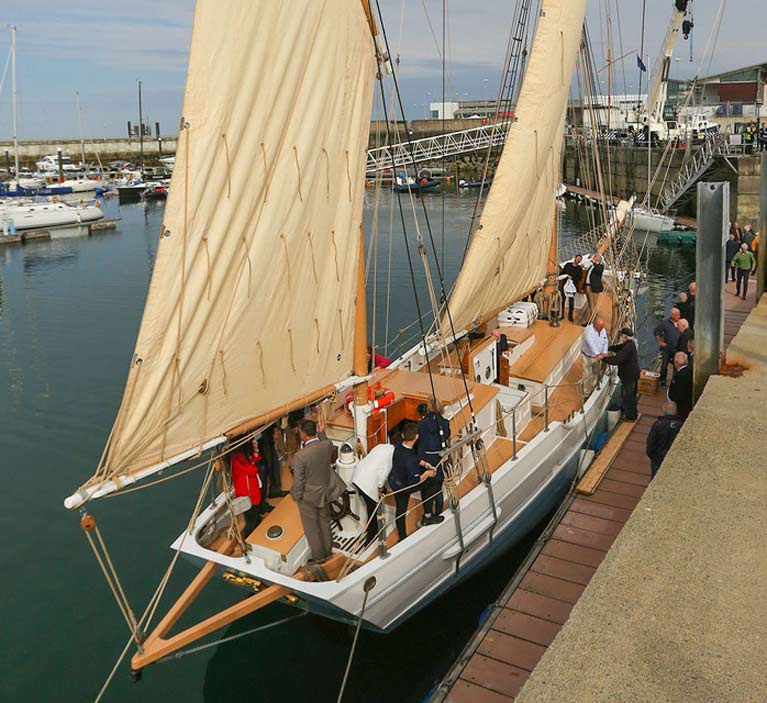 Ilen’s localised area of sunshine lasted for most of the reception at the RIYC. Photo: Deirdre Power
Ilen’s localised area of sunshine lasted for most of the reception at the RIYC. Photo: Deirdre Power
However, as this interaction was at its height in the 1920s, it’s clear that for many of today’s sailors, knowledge of O’Brien and his achievements are vague in the extreme, so the background to the story provides a useful context for the speech of welcome and encouragement which came from RIYC Commodore Joe Costello.
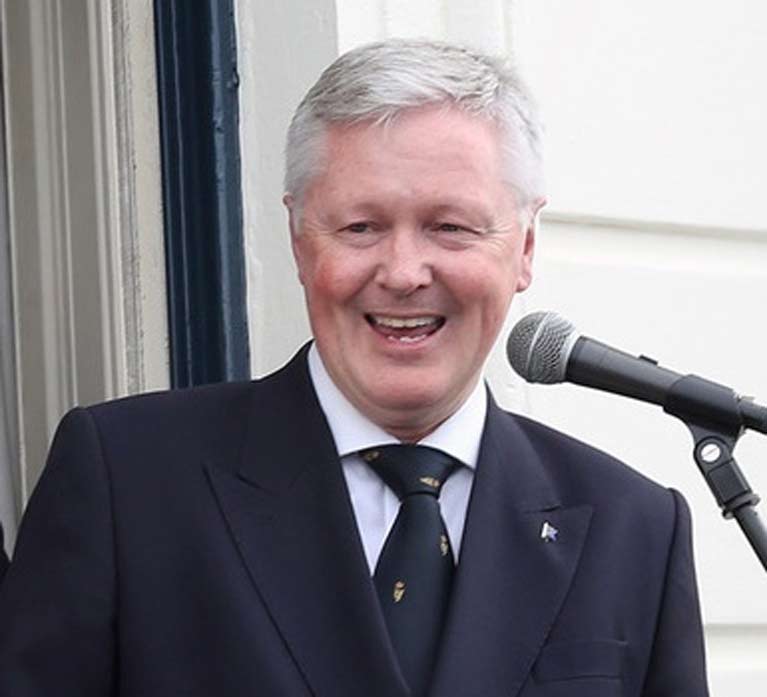 RIYC Commodore Joe Costello welcomes the Ilen back to his club’s fleet after an absence of 93 years. Photo: Deirdre Power
RIYC Commodore Joe Costello welcomes the Ilen back to his club’s fleet after an absence of 93 years. Photo: Deirdre Power
Conor O’Brien of Foynes Island in the Shannon Estuary in County Limerick lived from 1880 to 1952. A grandson of William Smith O’Brien of the Young Ireland movement, he was firstly a mountaineer who then became a pioneering ocean voyager when he was the first amateur sailor to circumnavigate the world south of the Great Capes including, of course, the legendary Cape Horn.
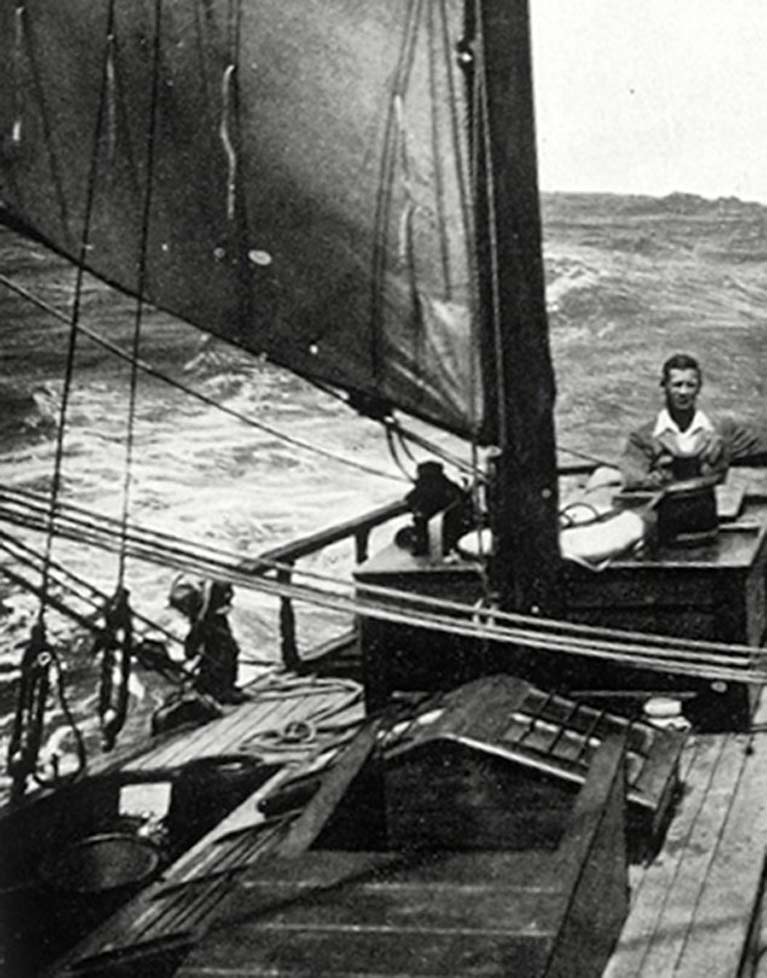 Conor O’Brien at the helm of Saoirse during the 1923-1925 round the world voyage, which began and ended at the RIYC
Conor O’Brien at the helm of Saoirse during the 1923-1925 round the world voyage, which began and ended at the RIYC
He did all this in 1923-1925 in the little 42ft gaff ketch called Saoirse, which he designed himself and had built by Tom Moynihan and his master shipwrights in Baltimore in West Cork. She was called Saoirse – “Freedom” as it is in English - to celebrate the establishment of the Irish Free State, of which he was a strong supporter – so much so, in fact, that he had aided Erskine Childers in the Howth gun-running of 1914, although he and Childers took opposing sides on the acceptance of the post War of Independence Treaty of 1921.
O’Brien withdrew from active political involvement, and instead devoted himself to getting his ideal of an ocean voyaging vessel built in Baltimore in 1922. Although he claimed that, in the first place, all his voyages really started and finished at his home port of Foynes Island, officially it was from his club, the Royal Irish YC in Dun Laoghaire on the 20th June 1923, that Saoirse’s great voyage got under way. And exactly two years later, on Saturday, June 20th 1925, Conor O’Brien and his little ship returned in triumph to this same spot, his magnificent voyage achieved.
Being a Saturday, Dublin Bay Sailing Club would normally have had a full racing programme in action. But in honour of O’Brien’s return, they cancelled racing, and their fleet provided Saoirse with a Guard of Honour as she returned to the harbour. Dublin Bay Sailing Club do not take such cancellations lightly – this was a very signal honour.
One unexpected outcome of the voyage was that when Saoirse had put into the Falkland Islands after rounding Cape Horn and sailing non-stop from New Zealand, the islanders were so impressed with the little ship’s seaworthiness that they advocated that they should have a larger version to be their inter-island ferry and freight vessel.
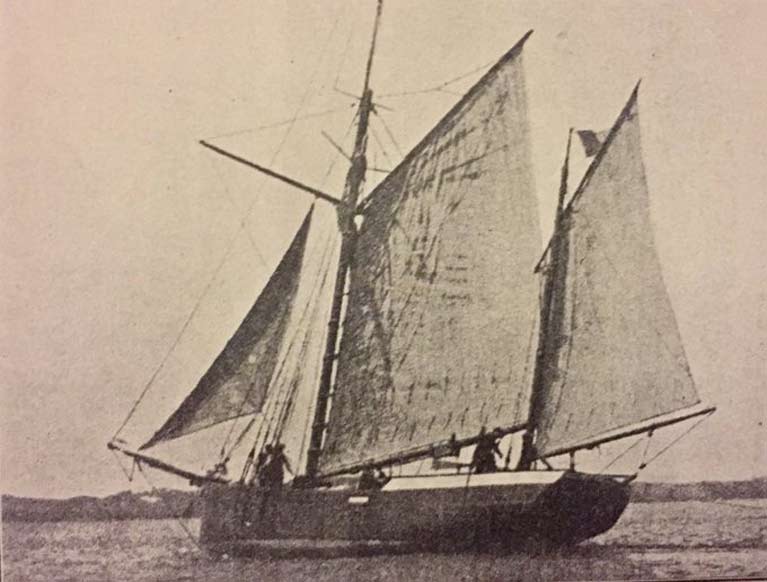 The newly-built Ilen sailing in Baltimore Harbour in 1926. Photo: Alice Foy
The newly-built Ilen sailing in Baltimore Harbour in 1926. Photo: Alice Foy
The result was that in 1926, Conor O’Brien found himself working again with Tom Moynihan in Baltimore, this time to create the 56ft ketch Ilen, which was undoubtedly Saoirse’s bigger sister.
Conor O’Brien personally delivered Ilen to the Falklands in 1926, crewed by two Cape Clear men, Con and Denis Cadogan. She was to give great service in those very rugged waters as a workboat for many decades, and when she was finally retired in the 1990s, Gary Mac Mahon of Limerick - who is both a Conor O’Brien enthusiast and a very considerable force of nature - decided that she should be shipped home to Ireland and restored to full seagoing condition in order to undertake voyaging with people who would benefit from such an experience, and also to remind us of our sometimes forgotten but nevertheless very great maritime traditions.
 Aboard Ilen sailing in Dublin Bay in May 1998, a few months after she’d been shipped back from the Falklands. At the deckhouse and living for the moment is Tim Magennis, possibly the only person in Ireland today who has sailed round the world under gaff rig Photo: W M Nixon
Aboard Ilen sailing in Dublin Bay in May 1998, a few months after she’d been shipped back from the Falklands. At the deckhouse and living for the moment is Tim Magennis, possibly the only person in Ireland today who has sailed round the world under gaff rig Photo: W M Nixon
 Tim Magennis – who recently celebrated his 90th birthday – at the RIYC after seeing the restored Ilen for the first time. Photo: Dermot Lynch
Tim Magennis – who recently celebrated his 90th birthday – at the RIYC after seeing the restored Ilen for the first time. Photo: Dermot Lynch
It was in November 1997 that Ilen was brought home. The fact that two decades later she was finally making her debut in this superbly restored style at the Royal Irish Yacht Club was doubly appropriate. Not only had Conor O’Brien used this as his start and finish point for his Saoirse circumnavigation in 1923-25, but when he came to deliver Ilen to the Falklands in 1926, he discovered that he was only insured as a Yachtmaster, and not as the Captain of a commercial vessel.
So when Ilen sailed out over the many thousands of miles of ocean to the Falklands, it was as part of the fleet of the Royal Irish Yacht Club – she flew the club burgee, and her club allegiance was proudly inscribed across her transom.
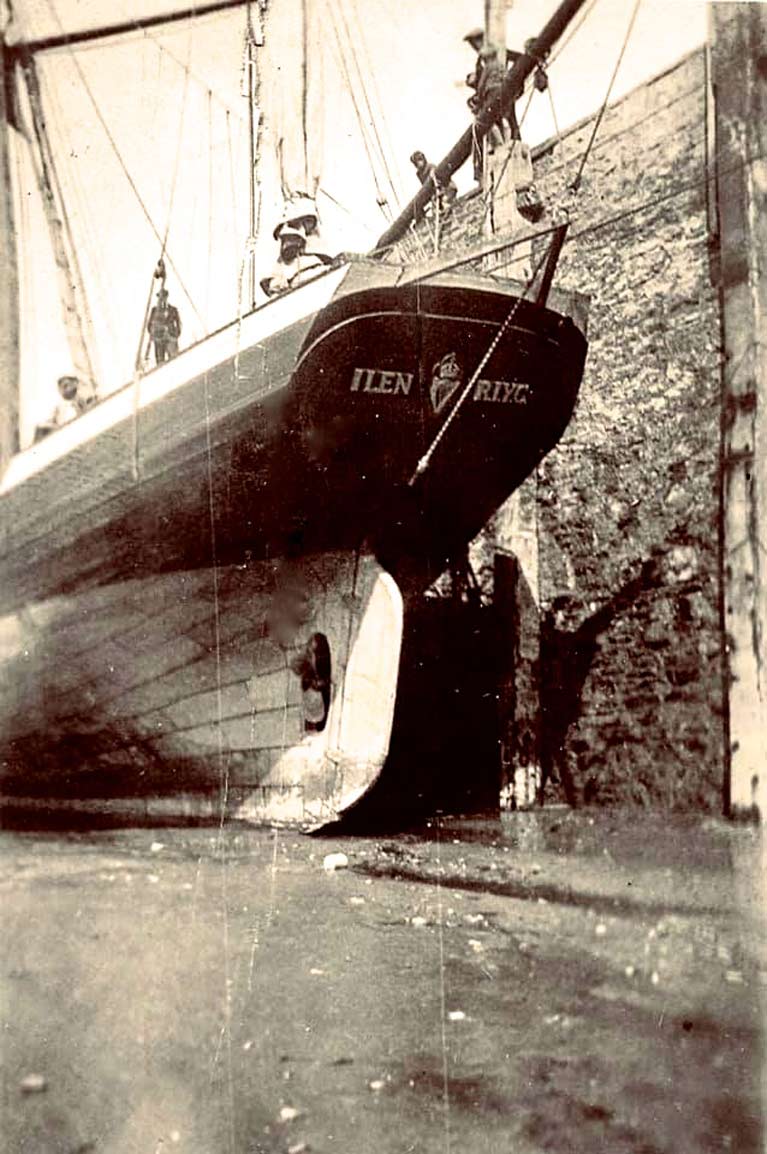
For six months, she was a yacht of the RIYC. Then she belonged in Port Stanley, and was a working boat. But now she is a Limerick ship. A little ship, perhaps, but undoubtedly a ship nevertheless, and a characterful one at that. She is very expressive of Conor O’Brien’s notions of what a hard-working seagoing vessel should look like, particularly in the matter of bowsprits. Like Saoirse before her, Ilen has a bowsprit which extends into the middle of next week, for that is the O’Brien way.
As we’re now in 2019, it is self-evident that the restoration of Ilen has been a long and challenging task, at times run on a shoestring. But thanks to the profound faith of Gary and his friends, Ireland has got to this remarkable stage of having a fully-certified seagoing traditional vessel which is currently in the midst of one of the very commendable Sailing into Wellness programmes,
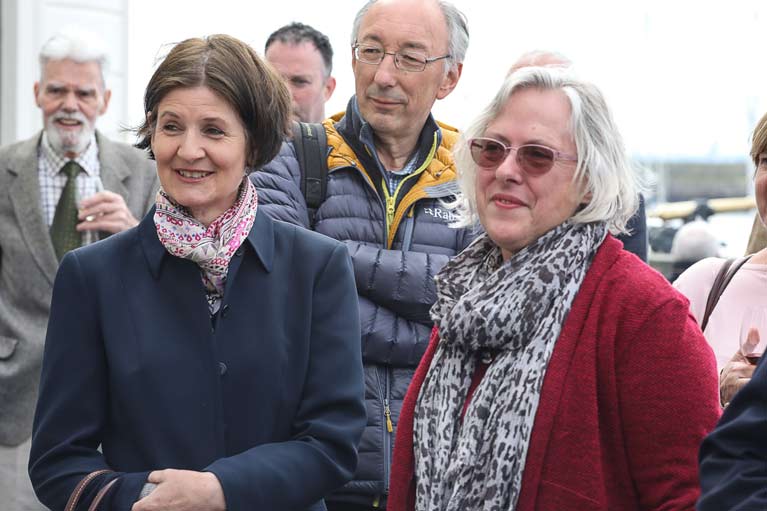 Although Conor O’Brien had no children of his own, his relatives are spread throughout Ireland – this is his grandniece Charlotte O’Brien Delamer with Stephanie O’Brien in Dun Laoghaire. Photo: Dermot Lynch
Although Conor O’Brien had no children of his own, his relatives are spread throughout Ireland – this is his grandniece Charlotte O’Brien Delamer with Stephanie O’Brien in Dun Laoghaire. Photo: Dermot Lynch
Then in July she’ll undertake a nine week educational voyage to Greenland from Limerick in the wake of the Atlantic salmon - a timely reminder of that splendid fish’s threatened status – while at the same time strengthening links which the Ilen Network has been building up between schools in the greater Limerick area and schools in southwest Greenland.
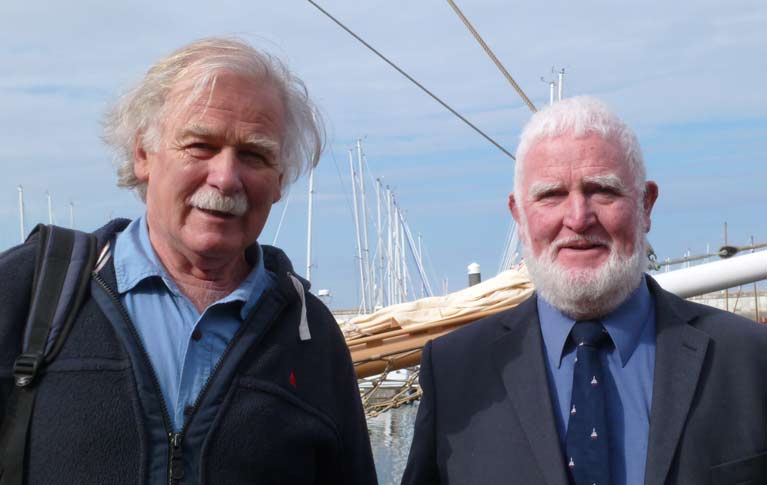 Experienced sailors of the west – Mick Brogan (left) and Jarlath Cunnane of Mayo will play a key role in bringing Ilen back from Greenland. Photo: W M Nixon
Experienced sailors of the west – Mick Brogan (left) and Jarlath Cunnane of Mayo will play a key role in bringing Ilen back from Greenland. Photo: W M Nixon
For the Ilen is now the symbol of a broad movement which has re-kindled awareness of the unique traditional vessels of Ireland, particularly those of the Shannon Estuary and West Cork. But were it not for this wonderful vessel at the centre of it all, the entire project would lack focus.
With the extraordinary balance of talents and almost magical chemistry between Gary Mac Mahon and Liam Hegarty and their respective teams, this restoration of exceptional authenticity has been achieved, aided in no small way by the spiritual support and guidance of Brother Anthony Keane of Glenstal Abbey.
 Celebrating the Ilen restoration at RIYC were (left to right) Patrick Keane SC, Deirdre Kinlen, Brother Anthony Keane of Glenstal Abbey, and Dr Sheila Javaepour. Photo: Donal Lynch
Celebrating the Ilen restoration at RIYC were (left to right) Patrick Keane SC, Deirdre Kinlen, Brother Anthony Keane of Glenstal Abbey, and Dr Sheila Javaepour. Photo: Donal Lynch
So we now have a proper flagship for the traditional and classic boat movement in Ireland, and we have a symbol for a form of sailing which is accessible to all - as such, the Ilen Project received the warmest praise from President Michael D Higgins when he visited the ship in Limerick last October.
This high-powered support for the “Ilen Ideals” was much in evidence at Dun Laoghaire’s gathering, where the presence of Dr Edward Walsh, founder of the University of Limerick, was matched by people like former RIYC Commodore Terry Johnson, whose remarkable record of service to sailing is augmented by work he has done on behalf of sail training, the lifeboat service, and other key pillars of the maritime world.
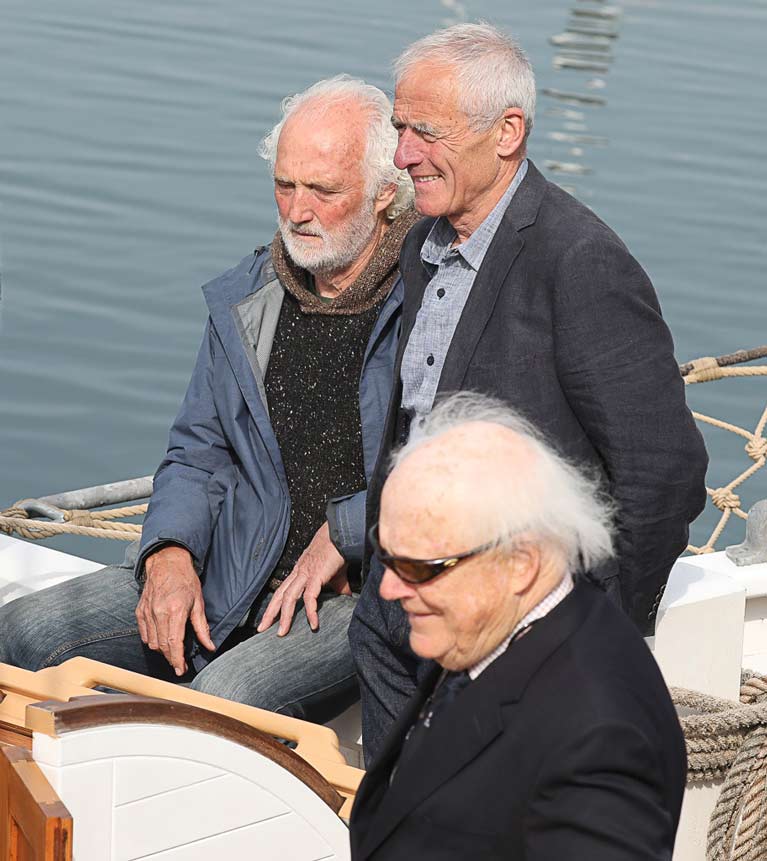 Former RIYC Commodore and maritime multi-tasker Terry Johnson (foreground) with renowned musician Brendan Begley (left) aboard Ilen. Photo: Dermot Lynch
Former RIYC Commodore and maritime multi-tasker Terry Johnson (foreground) with renowned musician Brendan Begley (left) aboard Ilen. Photo: Dermot Lynch
Also present were people who have given much practical assistance, such as Captain Gerry Burns of Irish Ferries, who in his leave periods served as a relief captain on the training Ship Asgard II. Since Ilen went afloat again, he has been journeying to Limerick to give master-classes in ship-handling to future Ilen skippers.
Another attendee was Tim Magennis, one of the few people who has sailed right round the world under gaff rig. When Ilen sailed briefly in Dublin Bay in May 1998 after she had been shipped back from the Falklands, Tim - a stalwart of the Old Gaffers Association – was one of those on board, and now 21 years later, having recently celebrated his 90th birthday, his delight in Ilen’s restoration was a joy to behold.
 Ilen Project supporter Harry Harbison, Gary Mac Mahon, and Sheila Deegan, Arts Officer of Limerick City & County Council. Photo: Dermot Lynch
Ilen Project supporter Harry Harbison, Gary Mac Mahon, and Sheila Deegan, Arts Officer of Limerick City & County Council. Photo: Dermot Lynch
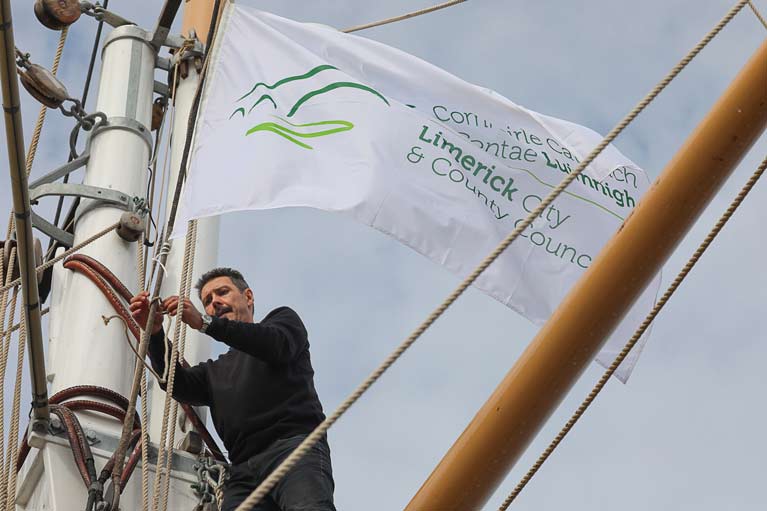 Rigging expert Trevor Ross ensures that the Limerick flag is aloft and flying. Photo: Dermot Lynch
Rigging expert Trevor Ross ensures that the Limerick flag is aloft and flying. Photo: Dermot Lynch
Although Conor O’Brien had no children, many people are related to him, and among those present were Charlotte O’Brien Delamer, his grandniece, and Stephanie O’Brien, married to another O’Brien relative.
For them, restoration of the Ilen was an intensely personal matter. But it was equally clear that many folk attending the RIYC reception found it especially moving that Ilen had been restored, and had now come to visit the club which meant so much to Conor O’Brien’s sailing.
Yet she’s a busy ship. Soon it was time to move on to Howth for a visit arranged by Wally McGuirk, where on Monday morning skipper Paddy Barry took a group of trainees from the inner-city Westland Row CBS out for some sailing experience on Ilen arranged through the Atlantic Youth Trust. Then in the afternoon, it was time to depart for Baltimore with the gift of a tankful of diesel from Howth Boat Club, on down to West Cork where the Wooden Boat Festival will serve up its own quota of emotional associations.
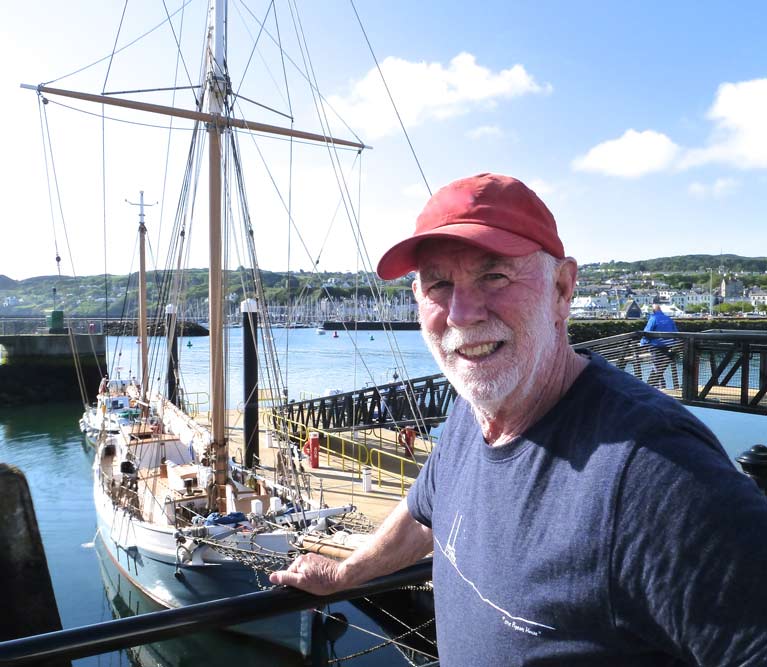 High latitudes veteran Paddy Barry with the Ilen in Howth on Monday morning. He’ll be aboard for the entire nine weeks voyage to Greenland. Photo: W M Nixon
High latitudes veteran Paddy Barry with the Ilen in Howth on Monday morning. He’ll be aboard for the entire nine weeks voyage to Greenland. Photo: W M Nixon
As a reminder of how things have slowly but steadily progressed, here’s a video by Paul Fuller of the then recently-launched and still largely unballasted Ilen making her debut at last year’s Festival in Baltimore. Now she is in full properly-ballasted seagoing order, ready and willing for further work at home before the voyage to Greenland gets underway from Limerick in July. It’s anticipation of this which will give the Baltimore Wooden Boat Festival 2019 an added dimension and an even more vivid flavour.
King of the Claddagh Michael Lynskey (88) and his community took to the Galway waterside at the weekend to welcome home a historic workboat which plied the Atlantic during two world wars writes Lorna Siggins
The 8m-long gleoiteog named Lovely Anne has been restored for sail training by Bádoirí an Cladaig.
Some ten nationalities were involved in refurbishing the gleoiteog, built by the well-known boatwright Patrick Brannelly in 1882 when German leader Otto von Bismarck and British prime minister William Gladstone were in power.
Master shipwright Coilín Hernon, who led the restoration with Ciarán Oliver, said Brannelly built a fleet of fine Galway hookers, with just three, including this gleoiteog, An Tonaí and the Morning Star surviving.
Brannelly died in an accident in his early 30s, when the Lovely Anne was being used to transport oysters between Bertraghboy Bay in Connemara and Rosmuc.
It passed through a number of owners in Connemara and on the Aran islands, was restored by Colm Breathnach at Camus, and was then acquired by Jim Parkinson of Killybegs, Co Donegal, who used it to fish salmon.
 The traditional Gleoiteog, the Lovely Anne, was re-launched at the Claddagh in Galway. Pictured on board the 137-year-old boat are Ross Forde, owner of the boat (left), and Pat Brannelly, both decendants of Patrick Brannelly who was the builder of the boat Photo: Joe O'Shaughnessy/Connacht Tribune
The traditional Gleoiteog, the Lovely Anne, was re-launched at the Claddagh in Galway. Pictured on board the 137-year-old boat are Ross Forde, owner of the boat (left), and Pat Brannelly, both decendants of Patrick Brannelly who was the builder of the boat Photo: Joe O'Shaughnessy/Connacht Tribune
Brannelly’s great great grandson, Ross Forde, who is involved with Bádoirí an Cladaig, traced the vessel to Killybegs and persuaded Parkinson to part with it. The refurbishment took five months, with Hernon and two of his sons cutting the sails and equipping the rig.
The Lovely Anne sailed over to Black Weir in Oranmore in the company of Mr Hernon’s gleoiteog, Nora Bheag, before returning to the Claddagh quay for its official welcome.
Mr Forde said that while over in Oranmore, he was told that the vessel had been named after an American woman named Anne, who was given a passage to a small island on it in rough conditions and described it as a “lovely boat”.
Bádoirí an Cladaig has endeavoured to extend its skills to non-sailing / fishing families through courses run with the Galway Roscommon Education and Training Board, and also held its inaugural festival in 2017.
Simon Wood, who had lived in Uganda for many years, and Harald Schlindwein from Germany are among the volunteers recruited by Badóirí an Cladaig, along with Liz Power, who is originally from Galway, and Niamh Moloughney, a Claddagh resident.
“I had been away from Galway for a number of years, and when I returned I wanted to get involved in something a bit bigger than me, “Ms Power explained.
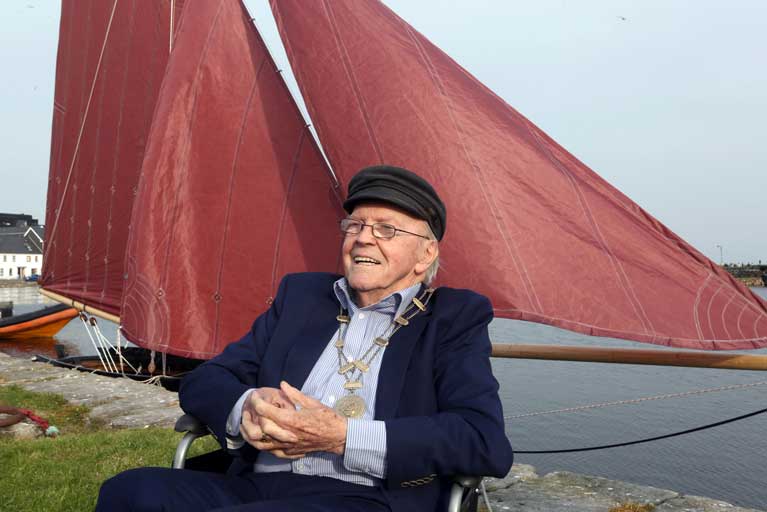 Michael Lynskey, King of the Claddagh, sits at Claddagh Quay during the re-launch of the Geloiteog, the Lovely Anne. Michael was the owner of the Galway Gleoiteog, Annie Photo: Joe O'Shaughnessy/Connacht Tribune
Michael Lynskey, King of the Claddagh, sits at Claddagh Quay during the re-launch of the Geloiteog, the Lovely Anne. Michael was the owner of the Galway Gleoiteog, Annie Photo: Joe O'Shaughnessy/Connacht Tribune
“We did a fair bit of sanding and a fair bit of watching Coilín Hernon doing his expert work,” Ms Moloughney laughed.
Relatives of both the boatbuilder and former owners of the vessel had attended the launch, including Mary Tipton, a relative of Brannelly, who flew from Cornwall, England.
“Not only is this an incredibly moving story of bringing our Galway heritage back to life, but we are extremely delighted to also announce that the Lovely Anne is now our dedicated training vessel,” Ciarán Oliver said. “We will be offering skills training classes for adults and children throughout 2019,” he added.
 Coilin Hernon at the re-launch of the Gleoiteog, the Lovely Anne, at Claddagh Quay in Galway. Coilin was one of the restorers of the 137-year-old boat. He and his sons Coilin Og and Einde also cut the sails for the Lovely Anne Photo: Joe O'Shaughnessy/Connacht Tribune
Coilin Hernon at the re-launch of the Gleoiteog, the Lovely Anne, at Claddagh Quay in Galway. Coilin was one of the restorers of the 137-year-old boat. He and his sons Coilin Og and Einde also cut the sails for the Lovely Anne Photo: Joe O'Shaughnessy/Connacht Tribune
The historic ketch Ilen of Limerick puts to sea again from her home port this weekend at the beginning of a complex 2019 sailing programme which will see the restored ship voyage in July towards southwest Greenland writes W M Nixon. She’ll be following in the wake of the migratory salmon which have journeyed since time immemorial between the Shannon and Greenland’s only salmon river, the Kapisillit at the head of a fjord at Nuuk, Greenland’s capital and Ilen’s primary destination.
Ireland’s last surviving sailing trading ketch, the 1926-built 56ft Ilen was originally designed by global circumnavigator Conor O’Brien to be the inter-island freight and ferry vessel in the Falkland Islands, and he sailed her out there after she’d been built by Tom Moynihan and his men at the Fishery Schools in Baltimore. When Ilen was retired from active service in the islands in the 1990s, Conor O’Brien enthusiast Gary Mac Mahon of Limerick set about trying to bring her home for restoration.
In November 1997 he achieved his first goal when Ilen was finally lifted off a ship in Dublin Docks. After wintering in the city’s Grand Canal basin, she sailed for the first time in many years in Dublin Bay in May 1998, and soon made the passage to West Cork for the Baltimore Wooden Boat Festival and the Glandore Classics Regatta.
 Ilen unloaded in Dublin Docks, November 1997 Photo: W M Nixon
Ilen unloaded in Dublin Docks, November 1997 Photo: W M Nixon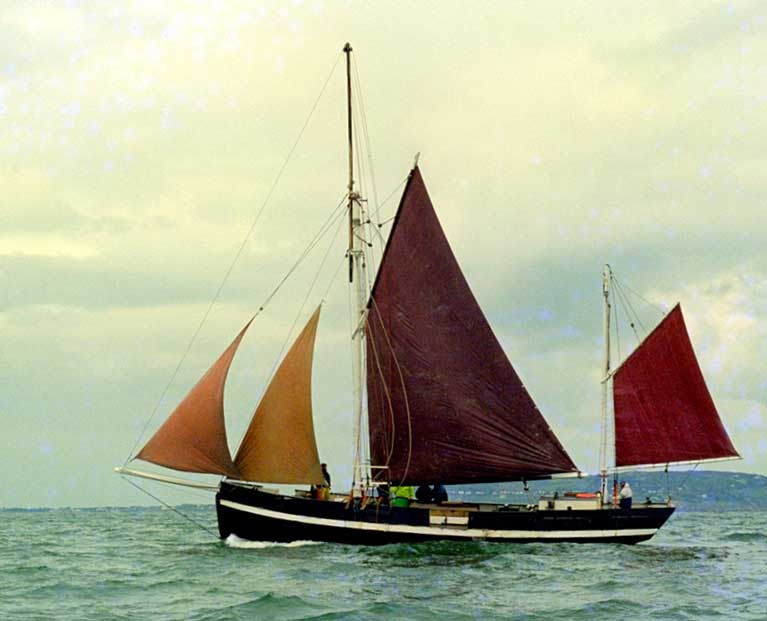 Ilen under sail for the first time in very many years, Dublin Bay May 1998. Photo: W M Nixon
Ilen under sail for the first time in very many years, Dublin Bay May 1998. Photo: W M Nixon
 Paddy Barry and Jarlath Cunnane aboard Ilen in Dublin Bay, May 1998. They are still very much involved in the Ilen Project. Photo: W M Nixon
Paddy Barry and Jarlath Cunnane aboard Ilen in Dublin Bay, May 1998. They are still very much involved in the Ilen Project. Photo: W M Nixon
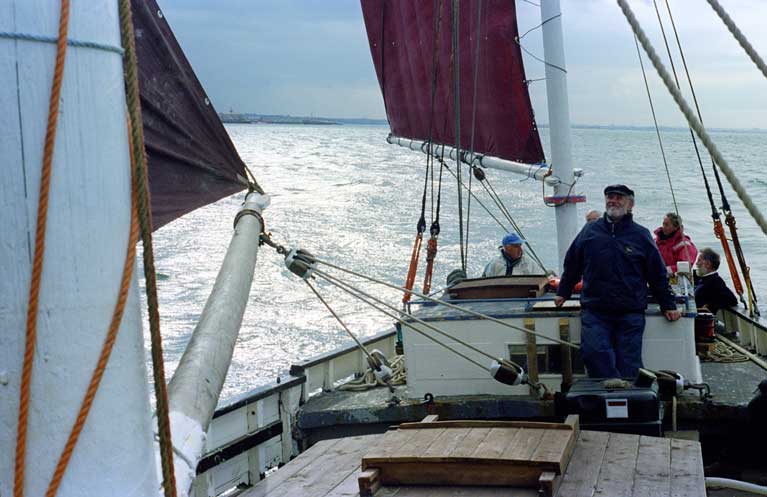 Aboard Ilen on that historic sail in Dublin Bay in May 1998 were several classic and traditional boat enthusiasts, including (left) Fionan de Barra, with Tim Magennis at deckhouse and Paddy Barry on the right. The restored Ilen returns to Dublin Bay in May 2019. Photo: W M Nixon
Aboard Ilen on that historic sail in Dublin Bay in May 1998 were several classic and traditional boat enthusiasts, including (left) Fionan de Barra, with Tim Magennis at deckhouse and Paddy Barry on the right. The restored Ilen returns to Dublin Bay in May 2019. Photo: W M Nixon
However, it was obvious that a huge project of restoration work was required to make the ship compliant with survey requirements for regular sea-going, and for several years she was virtually moth-balled. But in time a programme was devised – the Ilen Project – whereby the main hull restoration would be undertaken by master shipwright Liam Hegarty at Oldcourt Boatyard on the Ilen River above Baltimore in West Cork, while 180-kilometres away in Limerick, Gary Mac Mahon and the Ilen Network established an international project, the Ilen Boat-Building School, which made many of the detailed items such as the hatches and deckhouses, and the spars and rigging came out of this extensive Limerick workshop as well.
 Liam Hegarty (left) and Gary Mac Mahon at an early stage of Ilen’s hull restoration in Oldcourt
Liam Hegarty (left) and Gary Mac Mahon at an early stage of Ilen’s hull restoration in Oldcourt
All that work was in addition to other smaller boat-building projects undertaken in the School by a wide variety of trainees, many from an international background. These included a new fleet of the traditional Shannon gandelows, and other small craft including a Shannon angling cot and a flotilla of the economically-built yet very effective CityOne sailing dinghies, designed by the late naval architecture legend Theo Rye, who was an enthusiast for the entire Ilen programme.
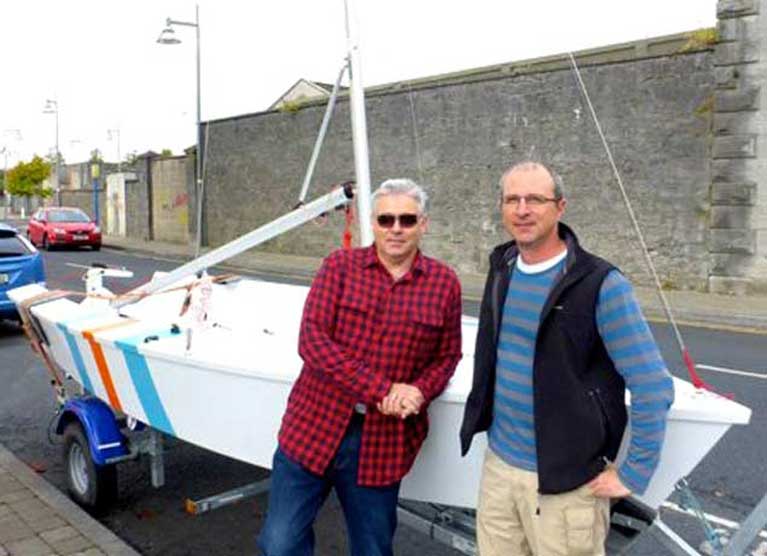 Gary MacMahon with the late Theo Rye and a new CityOne sailing dinghy in Limerick. Photo: W M Nixon
Gary MacMahon with the late Theo Rye and a new CityOne sailing dinghy in Limerick. Photo: W M Nixon
The Ilen Project in its broadest sense was by no means a matter of never-ending boat-building work. There was fun to be had. The gandelows were regular visitors to the Baltimore Woodenboat Festival as well as other events back north on the Shannon Estuary, while the CityOnes made their mark at the Glandore Classics and several regattas. Two of the Ilen seniors, Liam O’Donoghue and Tony Daly, travelled the length of the Erne and the Shannon from Belleek in Fermanagh to Limerick in an angling cot they’d built in the school, and of course when the Thousandth Anniversary of the Battle of Clontarf came up in 2014, as defenders of the proud Limerick memory of Brian Boru, the Ilen gandelow crews and their boats had to put in triumphant appearance on Dublin Bay.
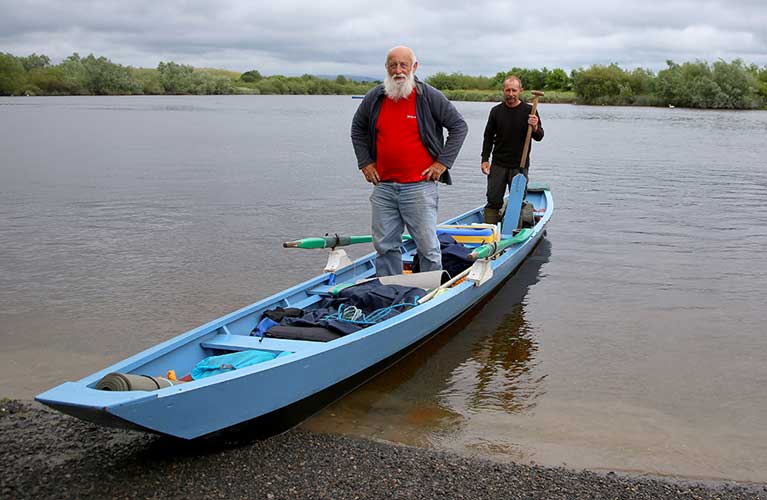 Liam O’Donoghue and Tony Daly with the Ilen School-built Shannon Angling Cot they rowed from Belleek in Fermanagh via the Erne and the Shannon all the way to Limerick
Liam O’Donoghue and Tony Daly with the Ilen School-built Shannon Angling Cot they rowed from Belleek in Fermanagh via the Erne and the Shannon all the way to Limerick
However, undoubtedly the most off-the-wall episode was taking the gandelows to one of the Festivals of the Sea in Venice. Folk from elsewhere may come up with ready wisecracks about “gandelow” being no more than the Limerick version of “gondola”, yet the citizens of the Serenissima went out of their way to make the Limerick crews and their boats welcome, and the entire visit was carried out with style and elan.
 The new traditional Shannon gandelows built by the Ilen School made a memorable visit to Venice.
The new traditional Shannon gandelows built by the Ilen School made a memorable visit to Venice.
But meanwhile, as resources permitted the restoration work on Ilen’s hull continued. The detailed joinery-work built in Limerick was added in as required, and finally, in January 2018, Ilen emerged re-born from the old Top Shed at Oldcourt. There was still much work to be done, but she was able to put in an appearance at the Baltimore Woodenboat Festival in May, and then finally at the end of September she was sufficiently ready for sea to voyage round to her home port of Limerick where, in a hectic first week of October, visiting well-wishers included President Michael D Higgins and his wife, Sabina.
![]() Finally brought together – the restored Ilen off Baltimore Beacon, September 2018. While the hull had been restored in Oldcourt, everything above deck except the sails had been made in Limerick. Photo: Declan Lynch
Finally brought together – the restored Ilen off Baltimore Beacon, September 2018. While the hull had been restored in Oldcourt, everything above deck except the sails had been made in Limerick. Photo: Declan Lynch
Ilen had spent all her life as a working boat, but now that she was so superbly restored, there was no way she was going to be treated as an ornament. On the contrary, it was planned that she would work in the areas of education, special assistance, and national and international cultural interaction, helping people young and old to develop as they learned to understand the ways of the past, the lore of seafaring, the story of Limerick’s magnificent waterborne trading history, and the mysteries and wonders of nature.
In an age of multi-faceted, continuous and wall-to-wall entertainment – electronic and otherwise – this was a tall order, and a “Big Idea” was needed to bring it into focus. Early projects with a variety of schools and other groups in the Greater Limerick area have produced encouraging results. It was and is evident that interacting with something as tangible as a traditional sailing vessel in almost any way can be a very rewarding experience for those new to it, and so the idea developed that a major flagship project for the summer of 2019 would clarify the focus on Ilen and all that she did – and all that she might do, too.
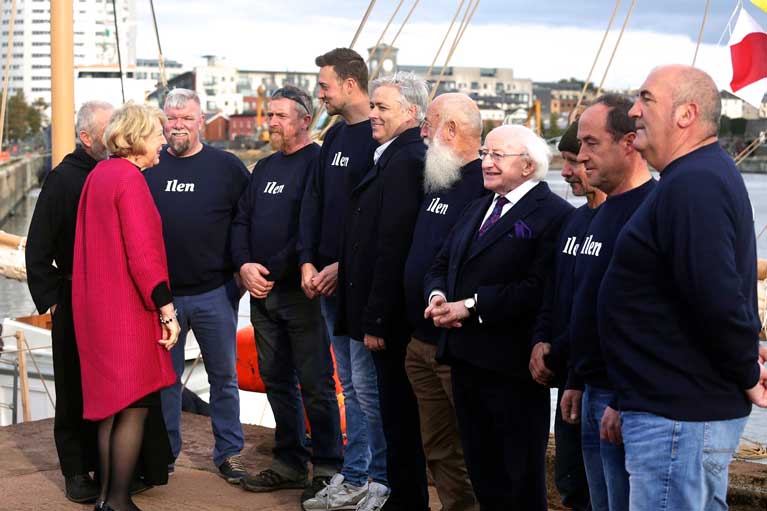 Almost immediately after returning to Limerick last October, Ilen enjoyed a Presidential visit
Almost immediately after returning to Limerick last October, Ilen enjoyed a Presidential visit
In an era of increasing awareness of the environment and the need for conservation and climate awareness, the “Big Idea” was right there, hidden in plain sight. While the numbers of Atlantic salmon passing through Limerick may have decreased markedly since the Ardnacrusha dam was built in the late 1920s and for other reasons, the salmon in the Shannon going to and from the sea are still very much part of the city’s culture. And it is known that while Atlantic salmon migrate to many rivers in several countries, in all of Greenland, they go to only one, the Kapisillit.
So why not sail Ilen in the salmon’s wake to this one special river with an Ilen Boat Building School-constructed Shannon angling cot as deck cargo, and thereby create a unique link around which a vibrant cultural interaction can be built between the schools and young people of Limerick and their counter-parts in southwest Greenland? The idea took hold, and it has developed as a busy project with schools in the greater Limerick area.
 In anticipation of the Salmon’s Wake voyage, schools in Limerick have been exchanging letters with their new pen-pals in Greenland
In anticipation of the Salmon’s Wake voyage, schools in Limerick have been exchanging letters with their new pen-pals in Greenland
This ambitious Salmons Wake Voyage will take over Ilen’s 2019 programme at the end of June. But meanwhile, the first part of the 2019 season involves Ilen interacting with the Sailing Into Wellness movement, with a series of short voyages along Ireland’s south and east coasts.
To position her for this and as part of the preparations for the Greenland voyage, over this Easter Weekend she’ll be making the passage from Limerick back to Baltimore and the Oldcourt Boatyard for a pre-season haul on Tuesday with a hull inspection, following which she’ll be making coastal passages with Sailing Into Wellness via ports such as Kinsale, Waterford and Howth until on Friday, May 17th she’s in Dun Laoghaire for a major presentation.
After that, the Sailing Into Wellness programme continues with a return to West Cork and the Baltimore Woodenboat Festival (24th May to 26th May), with an SIW Ilen base then established in Kinsale. But as June progresses, the ship will return to Limerick with preparations for the nine-week Greenland voyage being finalised.
 This traditional angling cot, currently in build at the Ilen School in Limerick, will be taken to Greenland as deck cargo on the Ilen. Photo: Gary MacMahonCommunication with the local Greenland community and two schools in Nuuk has been active, and in July it is planned that Deirdre Power of the Ilen Project and artist Chelsea Canavan from Limerick will be in residence in Nuuk to help in co-ordinating Ilen’s reception. That will include the visit to the Kapisillit River where the new-built Shannon angling cot currently being created by the Ilen Boat-Building School and brought to Nuuk by Ilen herself as deck cargo will be put afloat as a tangible symbol of many interacting links.
This traditional angling cot, currently in build at the Ilen School in Limerick, will be taken to Greenland as deck cargo on the Ilen. Photo: Gary MacMahonCommunication with the local Greenland community and two schools in Nuuk has been active, and in July it is planned that Deirdre Power of the Ilen Project and artist Chelsea Canavan from Limerick will be in residence in Nuuk to help in co-ordinating Ilen’s reception. That will include the visit to the Kapisillit River where the new-built Shannon angling cot currently being created by the Ilen Boat-Building School and brought to Nuuk by Ilen herself as deck cargo will be put afloat as a tangible symbol of many interacting links.
With such a programme, which will see Ilen sail between 5,000 and 6,000 miles by season’s end and dozens of ports visited, obviously very many people will be actively involved at different stages. But for the major ocean voyages, Gary Mac Mahon has been able to call on the services of a unique group of people who combine traditional boat sailing skills with extensive Arctic voyaging experience.
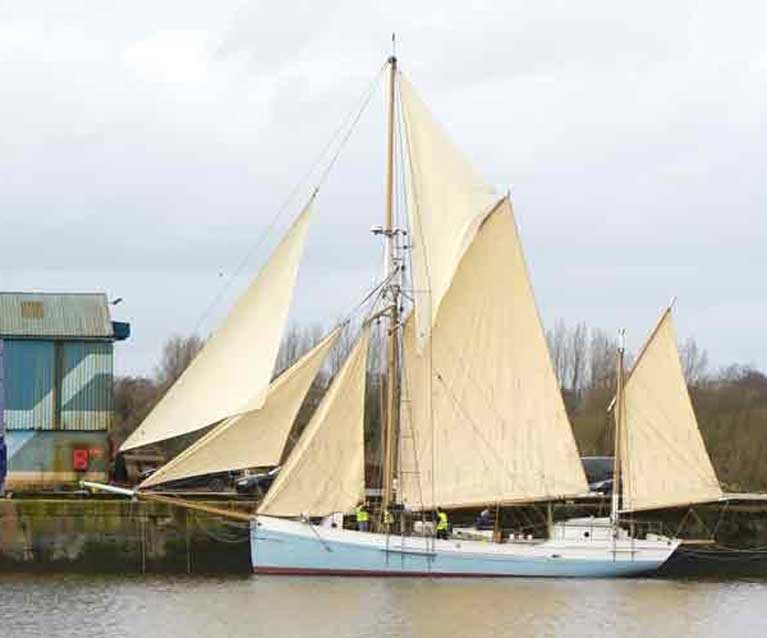 On a gentle day early in 2019 in Limerick, Ilen is finally able to set her complete new suit of fore-and-aft sails. Photo: Gary MacMahon
On a gentle day early in 2019 in Limerick, Ilen is finally able to set her complete new suit of fore-and-aft sails. Photo: Gary MacMahon
He himself is a veteran in this area, as one of his Arctic experiences was with the legendary Paddy Barry aboard the Galway hooker St Patrick, sailing far into northern latitudes.
Paddy Barry has been involved with the Ilen project from an early stage, as he was there at that special moment in November 1997 in Dublin Docks when Ilen was finally unloaded back in Ireland, he was in command when Ilen sailed again for the first time in very many years in Dublin Bay in May 1998, and over the long, challenging years of the restoration, he has been a ready source of encouragement and help.
He and Gary will both be in the ship’s complement for the outward passage to Nuuk and the many activities in Greenland itself. In fact, Paddy will be aboard for the entire nine weeks. But Gary’s time is limited, so for the return passage in August and early September, Paddy Barry will be joined by his partner in the Arctic circumnavigation of the Northabout, Northabout’s original builder, owner and skipper Jarlath Cunnane, and they will share the hugely experienced company of Dr Mick Brogan. These days, he’s best known as an organiser of Cruinnui na mBad at Kinvara, but like the other three, Mick Brogan is a seaman extensively versed in the ways of the Arctic and the needs and challenges of a traditionally-rigged ship.
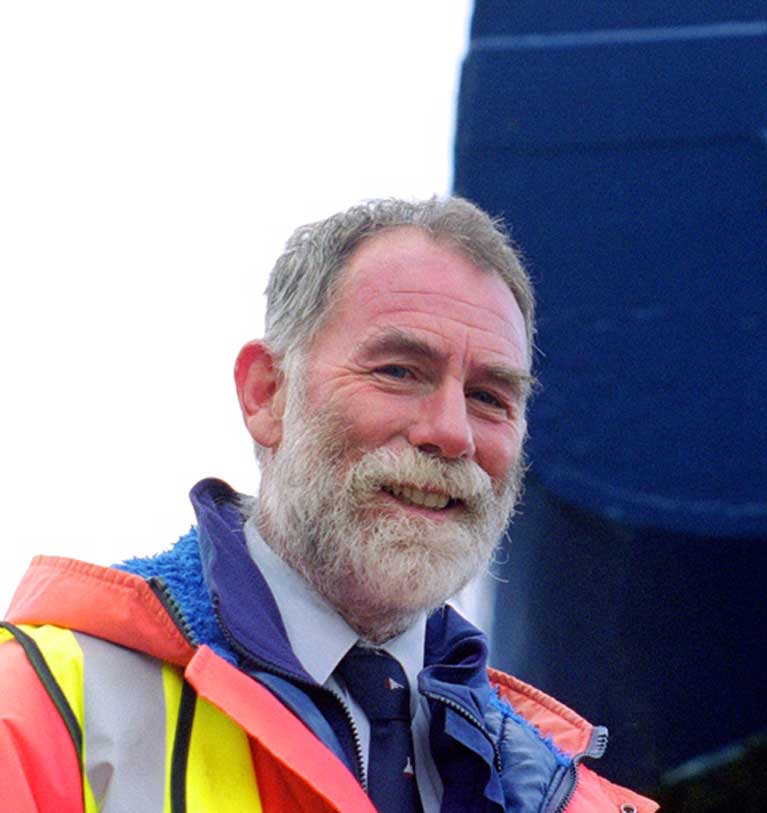 Paddy Barry at the unloading of Ilen in Dublin Port, November 1997. In 2019, he will be aboard throughout the nine weeks Salmons Wake voyage to Greenland. Photo: W M Nixon
Paddy Barry at the unloading of Ilen in Dublin Port, November 1997. In 2019, he will be aboard throughout the nine weeks Salmons Wake voyage to Greenland. Photo: W M Nixon
With Ilen’s departure today (Easter Saturday) from Limerick bound for Baltimore, these latest chapters in an extraordinary story get underway. Conor O’Brien’s account of the original voyage in 1926 from Foynes to the Falklands produced some of his best writing. But now that the old ship has become the Ilen Project, we find the story extending in several directions which somehow take in many places between Venice and Nuuk. It seems that when Gary Mac Mahon gets hold of an idea, all things are possible.
Traditional Sailing Techniques - Lets Not Forget Them
Yachts are marvels of engineering…. So I have been told – many times – at boat shows; by designers; builders; by sales staff; by sailors, amateur and professional; by proud owners….. Yachts are also nice to look at … I’ve liked, at various times, all the boats I’ve owned – my present Sigma 33, whose looks were the first to attract me … the Sadler 25, the Ruffian 23 I owned previously; even the Vagabond and Mirror dinghies I sailed in younger years…
On all of them, I learned about sailing…..Generally, they behaved well .. a “good sea boat” I was told, can look after itself, even if the sailor isn’t able to do so…!!!
Gradually over the years, I acquired more of the modern technology which made sailing better, safer, easier, so I was assured.
The design and construction of yachts accommodate them to their domain, the sea, which will, assuredly, challenge them at times….. The traditional techniques I learned included how to heave-to; to lie a-hull; to be aware of being over-canvassed; learning the approaching weather signs; when to reef and how to do it quickly and correctly and that there are times when the management of a small boat in a big sea, must be learned and understood….. hearing all that from those with more knowledge and experience….
As modern technology has taken over – and that continues to be the case, much of what was basic years ago has been changed - charts, paper and pencil to electronic navigation have been replaced…., GPS, Plotters and so on are great but what if they succumb to electronic faults…? The sea has many moods, so does the sailor and, perhaps at times, even electronic equipment….
"No qualifications are required to be produced to buy and own a yacht"
Yachtmaster and training courses are pathways to knowledge and skill, so too are experience and traditional techniques …. As yachts are built with materials better than ever before we are told and implanted with more and more technology, are traditional skills being passed on… maintained, preserved ….?????
No qualifications are required to be produced to buy and own a yacht and, while more regulatory controls are not particularly welcome in what is one of the last bastions of freedom… that of sailing…. Let’s not forget the traditional sailing techniques…..
Arklow-Built Classic is Honoured as Top Irish Gaff-Rigged Boat
Darryl Hughes’ renowned 43ft ketch Maybird, built by Tyrrell of Arklow in 1937 and superbly restored in substantial works project-managed by the owner himself in 2009-2011, has had – at 81 years old - probably her best year ever for awards in 2018 writes W M Nixon.
The highlight of her season was in July, when she became the first gaff-rigged boat to complete the 704-mile Volvo Round Ireland race from Wicklow. For this achievement, she received an immediate award from Wicklow SC and was immortalized in the gallery of ships’ portraits on the wall of Wicklow Pier itself, a special honour in a series created and lovingly maintained for many years by “Pat the Post”.
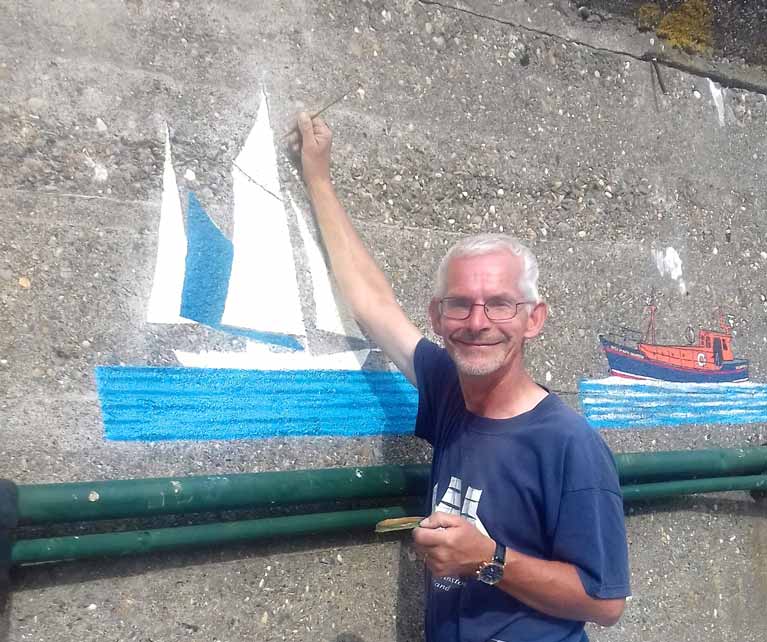 Wicklow’s “Pat the Post” creates one of his special portraits on Wicklow Pier in honour of Maybird.
Wicklow’s “Pat the Post” creates one of his special portraits on Wicklow Pier in honour of Maybird.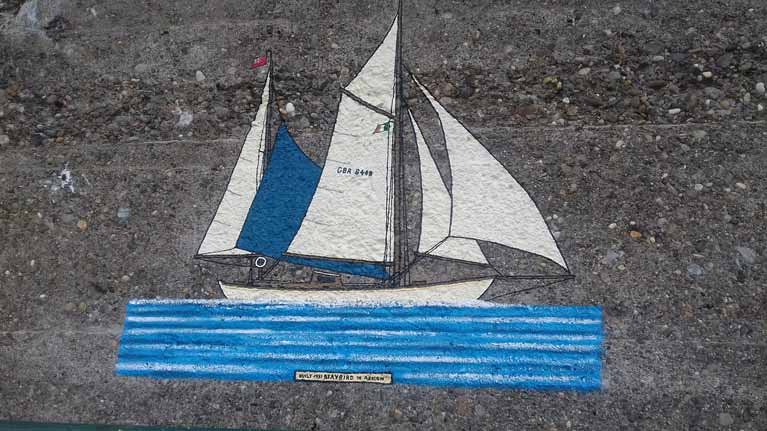 Maybird immortalized on Wicklow Pier
Maybird immortalized on Wicklow Pier
While this work was under way, Maybird meanwhile returned to her birthplace of Arklow for a week of celebration with Arklow Sailing Club and Arklow Sea Scouts, with sail-training sea-going groups availing of her presence for instructive gaff rig sessions, while the skipper and his round Ireland crew were honoured at the father-and-mother of all come-all-ye parties in ASC.
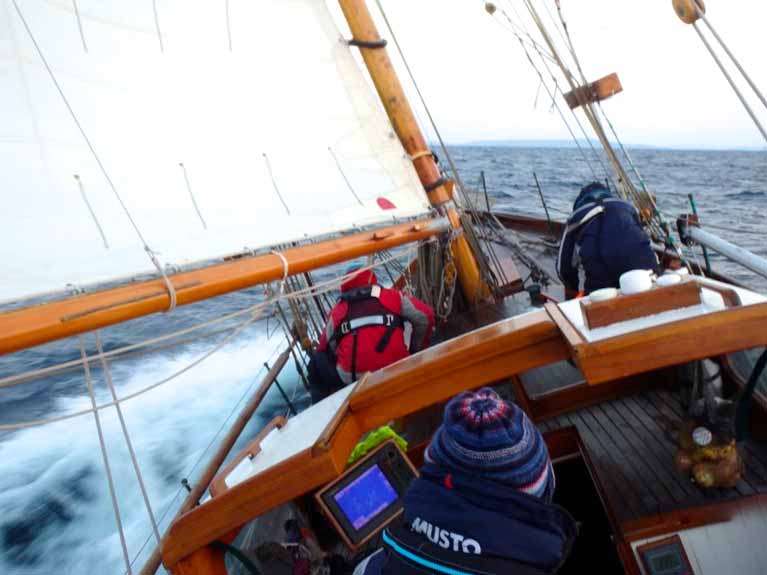 Aboard Maybird making knots during the Round Ireland race
Aboard Maybird making knots during the Round Ireland race
After this, the handsome ketch then sailed north, visiting several ports on a cruise which culminated in an Irish Cruising Club Rally at Rathlin Island on Ireland’s most northeasterly corner, and then in various ventures through the rest of the year she gradually got herself to Crosshaven where she has now been laid up for the winter, with her complex gear carefully stored.
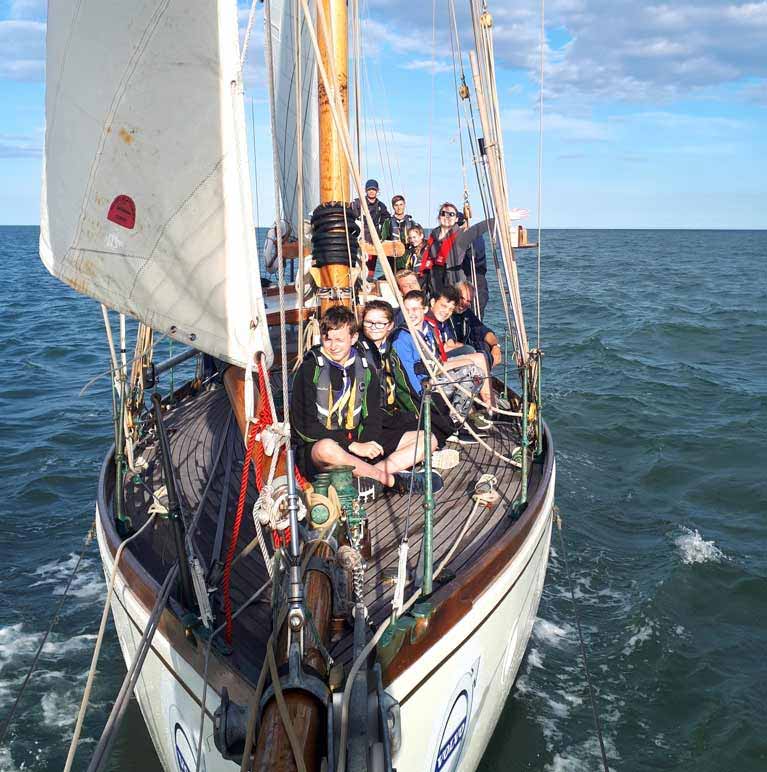 Arklow Sea Scouts out in strength on Maybird during the post-Round Ireland celebrations in her birthplace of Arklow
Arklow Sea Scouts out in strength on Maybird during the post-Round Ireland celebrations in her birthplace of Arklow
But with the end of the summer season, the flow of awards if anything increased. There was another trophy from Arklow Sailing Club at their annual awards ceremony. And then in November, Darryl Hughes found himself at the very convivial annual prize-giving of the Irish Sea Offshore Racing Association in the National Yacht Club in Dun Laoghaire, a black tie affair noted for its array of historical trophies.
Maybird had been obliged to do some ISORA Races in order to qualify for participation in the Round Ireland Race, and her crew enjoyed these events even though they hadn’t knowingly won anything in them. But in the NYC on that November Saturday night, it turned out they had – at the end of it all, Maybird’s name was called out as the winner of the Penmaen Plate.
The Penmaen Plate goes to the boat which best exemplifies “The Spirit of ISORA”. As Dun Laoghaire’s Peter Ryan, Chairman of ISORA, puts it: If you asked them to define the spirit of ISORA they’d be hard put to do so, but they know it when they see it, and in 2018 Maybird and her crew were the very embodiment of what they sought.
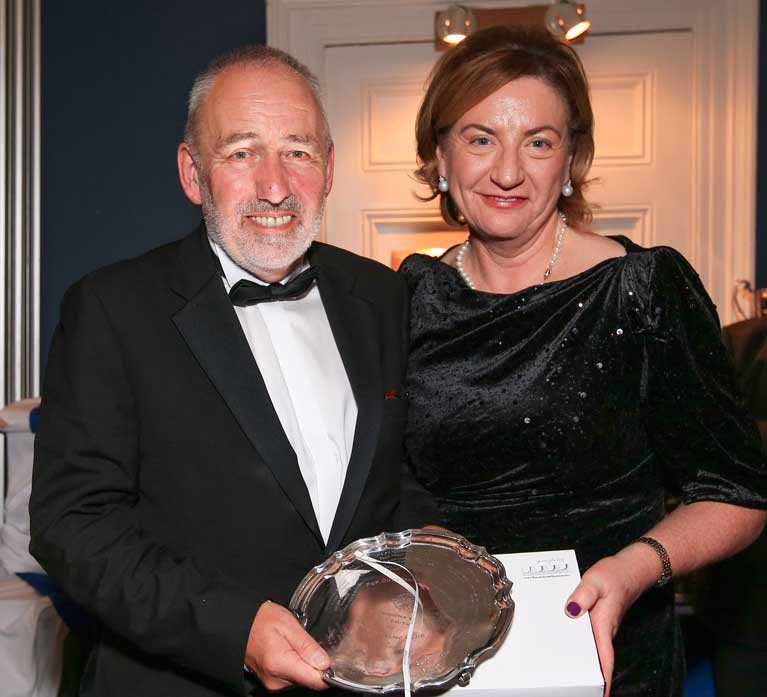 Darryl Hughes receives the Penmaen Plate from Anne-Marie Ryan, wife of ISORA Chairman Peter, at the ISORA Prize Giving Dinner in the National YC in Dun Laoghaire in November. Photo: gphoto
Darryl Hughes receives the Penmaen Plate from Anne-Marie Ryan, wife of ISORA Chairman Peter, at the ISORA Prize Giving Dinner in the National YC in Dun Laoghaire in November. Photo: gphoto
Darryl Hughes was busy in the late Autumn with voluntarily organizing the Irish Meteorology Society/Royal Institute for Navigation’s successful Weather & Sailing Conference in the Royal Irish YC on November 23rd. But after that he could relax back into normal life, and in late December he went along to the annual Christmas Party of the Dublin Bay Old Gaffers Association in Poolbeg Y&BC in the heart of Dublin, whose marina is Maybird’s home port when she’s on the East Coast.
And there, the season was finally fully rounded out when he found Maybird had become the 2018 winner of the Arthur Hughes Trophy, the top annual award of the DBOGA, named in honour of the memory of one of its key founders. So although Maybird already had been mightily honoured in Wicklow. Arklow and Dun Laoghaire, it was at Poolbeg in the final days of 2018 that she received the ultimate accolade as the top-achieving gaff rigged boat of the year
 It’s Christmas! Maybird is recognized as the top-achieving gaff rigged boat of 2018 at the Dublin Bay Old Gaffers Association Christmas Party in Poolbeg Y&BC, with the Arthur Hughes Trophy being presented to Darryl Hughes (right) by Negley Groom of DBOGA.
It’s Christmas! Maybird is recognized as the top-achieving gaff rigged boat of 2018 at the Dublin Bay Old Gaffers Association Christmas Party in Poolbeg Y&BC, with the Arthur Hughes Trophy being presented to Darryl Hughes (right) by Negley Groom of DBOGA.



























